The latest version of the law on advertising in the Russian Federation was published on October 10, 2015. The first text was approved by the Duma on February 22, 2006. As in all other cases, in the course of its work, the Federal Law was constantly supplemented, and some of its dispositions and provisions lost their legal meaning, and therefore were immediately canceled. Next, we will acquaint you with the latest changes in the field of promoting alcohol, tobacco products, medical services and goods.
Changes in the law on advertising for 2016
The current text of the law has also undergone some revisions over the past few years. In particular, now Article 22 no longer works, because it was declared null and void. But the legislation Russian Federation insists that even canceled dispositions be specified in laws and codes.
The new format is another confirmation of the above - the distribution of goods traditional medicine must now be accompanied by a proper set of documents. The amendments also touched upon certain requirements for the constituent entities of the Russian Federation (for example, for the Krasnodar and Stavropol Territories).
The most recently revised promotional provisions of the Advertising Law dealt with fair competition (Chapter 5). The goals and scope of action remained the same - information about unfair competition will be transferred to the state executive body, which has the right to protect and fully control legal relations in this area (FAS).
Placement of outdoor advertising in Moscow, Moscow region according to the law on advertising
In Moscow, the Moscow region and other large administrative centers and regions of Russia, outdoor advertising is placed in the same manner as in all other regions of the country.
However, in the Moscow region, the provisions of the Federal Law were supplemented by local definitions. For example, advertising events (this also applies to Moscow) should not be antisocial in nature and violate consumer rights (the so-called social).
Outdoor advertising in any of its expressions cannot be placed on architectural monuments, road signs, cultural objects, or without an agreement with the owner of the building or land. And this rule also applies to the administration of the region.
Are pavement signs prohibited by the latest edition of the advertising law?
The use of pillars in the Russian Federation is not yet prohibited. Such constructions should not contain anything illegal, and be placed in compliance with the norms noted in the act we are describing with changes. There is a lot of not entirely relevant information on the prohibition of pavement signs on the Internet - this is a complete delusion, since nothing is said about this in the law of the Russian Federation under consideration.
Facade Advertising Law - Basic Provisions
As already noted, in order to place any advertising information on the facade of a building, it is necessary to obtain permission and come to an agreement with the city administration. Signs on houses, streets, the facade of a building (or a residential building), even on your own balcony, must be discussed in advance with the administration, or with the management company. The content of the advertising poster is checked for illegal statements, appeals, etc.
At the same time, according to the law on advertising in the latest edition on cars and any other transport (the exception is public transport, since the information on it is also subject to correction), you can advertise any admissible object or service without restrictions.
Law on Advertising of Medical Services and Products - Regulations
This provision prescribes the observance of the following imperatives if you wish to promote a particular medical product:
- it is forbidden to address children (and even use children's images);
- promotion of untested and ineffective drugs is not allowed;
- the promotion of medicines as an alternative to a doctor's visit is prohibited.
Plus, of course, if there are contraindications, then they should be mentioned. More details on the entire list can be found in article 24 of the act.
Advertising of beer and alcohol from January 1, 2015 - what is allowed and prohibited by the acon?
Any mention of alcohol with a reference to its usefulness or harmlessness is not allowed from the TV screen, radio, pano, etc. In this version, images (even drawn) of people should also not be used. At the end of any such announcement, there must be information that this alcoholic product, when consumed in large quantities, can cause serious harm to health.
Something is expected to change for the 2016 FIFA World Cup (but this will not affect hard liquor and tobacco).
Advertising of financial services
The promotion of any banking, appraisal, insurance and other specialized financial services and similar activities (even on television) must necessarily contain the strict name or details of the person offering these services or conducting such activities.
with comments
1. Distribution of outdoor advertising using billboards, stands, building nets, banners, electronic displays, balloons, balloons and other technical means of stable territorial distribution (hereinafter - advertising structures), mounted and located on external walls, roofs and other structural elements of buildings, structures, structures or outside them, as well as stopping points for public transport, is carried out by the owner of the advertising structure, who is an advertising distributor, in compliance with the requirements of this article. Owner of an advertising structure (natural or legal person) - the owner of an advertising structure or another person who has a property right to an advertising structure or the right to own and use an advertising structure on the basis of an agreement with its owner.
2. The advertising structure must be used exclusively for the purpose of distributing advertising, social advertising.
(as amended by Federal Law of 21.07.2007 N 193-FZ)
3. Distribution of advertising on the sign road traffic, its support or any other device designed to regulate traffic is not allowed.
4. The advertising structure and its territorial location must comply with the requirements of the technical regulations.
5. Installation and operation of an advertising structure is carried out by its owner under an agreement with the owner of a land plot, building or other immovable property to which the advertising structure is attached, or with a person authorized by the owner of such property, including the tenant. If the common property of the owners of premises in an apartment building is supposed to be used for the installation and operation of an advertising structure, the conclusion of a contract for the installation and operation of an advertising structure is possible only with the consent of the owners of premises in an apartment building, obtained in accordance with the procedure established by the Housing Code of the Russian Federation. The conclusion of such an agreement is carried out by a person authorized to conclude it by the general meeting of owners of premises in an apartment building. The contract for the installation and operation of an advertising structure is concluded for a period of five years, with the exception of a contract for the installation and operation of a temporary advertising structure, which may be concluded for a period not exceeding twelve months. Upon the expiration of the contract for the installation and operation of the advertising structure, the obligations of the parties under the contract terminate. The conclusion of an agreement for the installation and operation of an advertising structure is carried out in accordance with the norms of this Federal Law and civil legislation.
(as amended by Federal Laws of 21.07.2007 N 193-FZ, of 27.09.2009 N 228-FZ)
5.1. The conclusion of an agreement for the installation and operation of an advertising structure on a land plot, building or other real estate in state or municipal ownership is carried out on the basis of tenders (in the form of an auction or competition) held by state authorities, local authorities or organizations authorized by them in in accordance with the legislation of the Russian Federation. The form of bidding (auction or competition) is established by public authorities or representative bodies municipalities.
(part five.1 introduced by the Federal Law of July 21, 2007 N 193-FZ)
5.2. A participant in a tender (in the form of an auction or a competition) does not have the right to be a person occupying a preferential position in the distribution of outdoor advertising at the time of filing an application for participation in the auction. If, based on the results of the auction or competition, a person acquires an advantageous position, these results are invalid.
(Part five.2 was introduced by Federal Law of July 21, 2007 N 193-FZ)
5.3. The preferential position of a person in the field of distribution of outdoor advertising on the territory of a municipal district or an urban district, the territories of federal cities of Moscow and St. Petersburg is recognized as the position of a person in which his share in this area in these territories exceeds thirty-five percent (unless no more than ten advertising structures are installed on the territory of a municipal district or urban district). The share of a person in the field of outdoor advertising is defined as the ratio of the total area of information fields of advertising structures, the installation permits of which were issued to the person and his affiliates in the relevant territory, to the total area of information fields of all advertising structures, the installation permits of which were issued in this territory. For the purposes of this article, an information field of an advertising structure means a part of an advertising structure intended for advertising distribution.
(part five.3 was introduced by the Federal Law of July 21, 2007 N 193-FZ)
5.4. When determining the total area of information fields of advertising structures, permissions for the installation of which were issued to one person, the areas of information fields of temporary advertising structures are taken into account. Temporary advertising structures are advertising structures, the term of placement of which is determined by their functional purpose and place of installation (construction nets, fences of construction sites, places of trade and other similar places, other similar technical means) and is no more than twelve months.
(part five.4 introduced by Federal Law of July 21, 2007 N 193-FZ)
5.5. To participate in an auction (auction or tender), a person is obliged to provide, respectively, to a state authority, a local self-government body information on the total area of information fields of advertising structures, permits for the installation of which were issued to this person and his affiliates in the relevant territory.
(Part five.5 was introduced by Federal Law of July 21, 2007 N 193-FZ)
5.6. An auction or tender for the conclusion of an agreement for the installation and operation of an advertising structure on a land plot, building or other real estate that is in state or municipal ownership and on which, on the basis of an agreement between a state authority, a local government body and the owner of an advertising structure, an advertising construction, carried out after the expiration of the contract for the installation and operation of the advertising structure.
(Part five.6 introduced by Federal Law of 21.07.2007 N 193-FZ)
5.7. If one participant is admitted to participate in an auction or competition, the auction or competition is declared invalid. Subject to the requirements established by parts 5.2 - 5.5 of this article, the contract for the installation and operation of the advertising structure is concluded with the person who was the only participant in the auction or tender.
(Part five was introduced by the Federal Law of July 21, 2007 N 193-FZ)
6. In the event that the real estate to which the advertising structure is attached is assigned by the owner to another person on the basis of the right of economic management, the right of operational management or other proprietary right, the contract for the installation and operation of the advertising structure is concluded with the person having the right of economic management, the right operational management or other property rights to such immovable property, subject to the consent of such an owner and in compliance with the requirements established by parts 5.1 - 5.5 of this article.
(as amended by Federal Law of 21.07.2007 N 193-FZ)
7. In the event that the real estate, to which the advertising structure is attached, has been transferred by the owner to trust management, the contract for the installation and operation of the advertising structure is concluded with the trustee, provided that the contract trust management does not restrict the trustee in performing such actions with the relevant property.
8. For the duration of the contract, the owner of the advertising structure has the right to unimpeded access to the real estate to which the advertising structure is attached, and to use this property for purposes related to the exercise of the rights of the owner of the advertising structure, including its operation, maintenance and dismantling.
9. Installation of an advertising structure is allowed if there is a permit for the installation of an advertising structure (hereinafter also referred to as a permit) issued on the basis of an application from the owner or other legal owner of the relevant real estate or owner of an advertising structure specified in parts 5-7 of this article by the local government of the municipal district or the local government body of the city district, in the territories of which it is planned to install the advertising structure.
9.1. A permit to install an advertising structure on a land plot, building or other immovable property, regardless of the form of ownership of immovable property, is issued to a person who does not have a preferential position in the field of outdoor advertising in accordance with parts 5.3 and 5.4 of this article.
(part nine.1 introduced by the Federal Law of July 21, 2007 N 193-FZ)
9.2. Permits issued by a local self-government body of a municipal district or a local self-government body of an urban district in violation of the requirements of parts 5.1, 5.2, 5.5 - 5.7 and 9.1 of this article are subject to cancellation on the basis of an order of the antimonopoly body.
(Part nine.2 was introduced by Federal Law of July 21, 2007 N 193-FZ)
9.3. A person who has been issued a permit to install an advertising structure is obliged to notify the local government that issued such a permit about all facts of rights arising from third parties in relation to this advertising structure (renting an advertising structure, making an advertising structure as a contribution under a simple partnership agreement) , conclusion of a trust management agreement, other facts).
(Part nine.3 was introduced by Federal Law of July 21, 2007 N 193-FZ)
10. Installation of an advertising structure without permission (unauthorized installation) is not allowed. In case of unauthorized installation of a new advertising structure, it must be dismantled on the basis of an order of the local government body of the municipal district or the local government body of the city district, in the territories of which the advertising structure is installed.
11. The application specified in part 9 of this article shall be accompanied by:
1) data on the applicant - an individual or data on the state registration of a legal entity or state registration of an individual as an individual entrepreneur;
2) confirmation in writing of the consent of the owner or other legal owner of the respective immovable property specified in paragraphs 5 - 7 of this article to attach an advertising structure to this property, if the applicant is not the owner or other legal owner of the immovable property. If the installation and operation of an advertising structure requires the use of the common property of the owners of premises in an apartment building, the document confirming the consent of these owners is the minutes of the general meeting of owners of premises in an apartment building.
(as amended by the Federal Law of 27.09.2009 N 228-FZ)
12. The local self-government body of the municipal district or the local self-government body of the city district is not entitled to require the applicant to submit documents and information not related to the territorial location, appearance and the technical parameters of the advertising structure, as well as collect, in addition to the state duty, an additional fee for the preparation, execution, issuance of a permit and other actions related to the issuance of a permit.
13. The local self-government body of the municipal district or the local self-government body of the urban district independently carries out the coordination with the authorized bodies necessary for making a decision on issuing a permit or refusing to issue it. At the same time, the applicant has the right to independently obtain such an agreement from the authorized bodies and submit it to the local self-government body of the municipal district or the local self-government body of the city district.
14. A written decision on the issuance of a permit or on the refusal to issue it must be sent by the local self-government body of the municipal district or the local self-government body of the urban district to the applicant within two months from the date of receipt from him required documents... An applicant who has not received, within the specified time limit, from a local self-government body of a municipal district or a local self-government body of an urban district, a written decision to issue a permit or to refuse to issue it, within three months, has the right to apply to a court or an arbitration court with an application for recognizing the inaction local government illegal.
15. The decision to refuse to issue a permit must be motivated and taken by a local government body of a municipal district or a local government body of an urban district solely on the following grounds:
1) inconsistency of the design of the advertising structure and its territorial placement with the requirements of the technical regulations;
2) inconsistency of the installation of the advertising structure in the declared place with the territorial planning scheme or the general plan;
3) violation of the requirements of regulatory enactments on traffic safety;
4) violation of the external architectural appearance of the existing development of a settlement or urban district;
5) violation of the requirements of the legislation of the Russian Federation on cultural heritage objects (historical and cultural monuments) of the peoples of the Russian Federation, their protection and use;
6) violation of the requirements established by parts 5.1 - 5.7 and 9.1 of this article.
16. If the local self-government body of the municipal district or the local self-government body of the urban district refuses to issue a permit, the applicant, within three months from the date of receipt of the decision to refuse to issue the permit, has the right to apply to the court or the arbitration court with an application to declare such a decision illegal.
17. A permit is issued by a local self-government body of a municipal district or a local self-government body of an urban district for each advertising structure for the duration of the contract for the installation and operation of the advertising structure. The permit specifies the owner of the advertising structure, the owner of the land plot, building or other real estate to which the advertising structure is attached, the type of the advertising structure, the area of its information field, the place of installation of the advertising structure, the validity period of the permit, the authority that issued the permit, its number and date. issue, other information.
(as amended by Federal Law of 21.07.2007 N 193-FZ)
18. The local self-government body of the municipal district or the local self-government body of the urban district, the decision to revoke the permit is taken:
1) within a month from the date the owner of the advertising structure sends him a notice in writing about his refusal to further use the permit;
2) within a month from the moment the owner or other legal owner of the immovable property to which the advertising structure is attached to him, a document confirming the termination of the contract concluded between such owner or such owner of the immovable property and the owner of the advertising structure;
3) if the advertising structure has not been installed within a year from the date of issue of the permit;
4) if the advertising structure is used not for the purpose of distributing advertising, social advertising;
(as amended by Federal Law of 21.07.2007 N 193-FZ)
5) if a permit was issued to a person who entered into an agreement for the installation and operation of an advertising structure in violation of the requirements established by parts 5.1 - 5.7 of this article, or the results of an auction or competition are invalidated in accordance with the legislation of the Russian Federation;
(Clause 5 was introduced by the Federal Law of July 21, 2007 N 193-FZ)
6) in case of violation of the requirements established by parts 9.1 and 9.3 of this article.
(Clause 6 was introduced by the Federal Law of July 21, 2007 N 193-FZ)
19. The decision to annul a permit may be appealed to a court or an arbitration court within three months from the date of its receipt.
20. A permit may be declared invalid in a judicial proceeding if:
1) repeated or gross violation by the advertising distributor of the legislation of the Russian Federation on advertising - at the suit of the antimonopoly authority;
2) detection of non-compliance of the advertising structure and its territorial placement with the requirements of technical regulations - at the request of the body that monitors compliance with technical regulations;
3) inconsistency of the installation of an advertising structure in a given place with a territorial planning scheme or a general plan - at the suit of a local government body;
4) violation of the external architectural appearance of the existing development of a settlement or urban district - at the request of a local government body;
5) non-compliance of the advertising structure with the requirements of regulatory enactments on traffic safety - at the suit of the body that monitors traffic safety;
6) the emergence of a preferential position in accordance with parts 5.3 and 5.4 of this article - at the suit of the antimonopoly authority.
(Clause 6 was introduced by the Federal Law of July 21, 2007 N 193-FZ)
21. If the permit is canceled or invalidated, the owner of the advertising structure or the owner or other legal owner of the relevant real estate to which such a structure is attached shall be obliged to dismantle the advertising structure within a month and delete the information posted on such an advertising structure within three days.
(as amended by Federal Law of 21.07.2007 N 193-FZ)
22. In case of failure to fulfill the obligation to dismantle the advertising structure, the local self-government body of the municipal district or the local self-government body of the city district has the right to apply to a court or arbitration court with a claim for compulsory dismantling of the advertising structure. If a court or arbitration court makes a decision on the compulsory dismantling of an advertising structure, its dismantling, storage or, if necessary, destruction is carried out at the expense of the owner or other legal owner of the real estate to which the advertising structure was attached. At the request of the owner or other legal owner of such immovable property, the owner of the advertising structure is obliged to reimburse him for reasonable expenses incurred in connection with the dismantling, storage or, if necessary, destruction of the advertising structure.
22.1. In case of failure to fulfill the obligation to delete the information posted on the advertising structure in case of revocation of the permit or its invalidation, the owner or other legal owner of the real estate to which the advertising structure was attached shall delete this information at his own expense. At the request of the owner or other legal owner of such immovable property, the owner of the advertising structure is obliged to reimburse him for reasonable expenses incurred in connection with the removal of this information.
(Part twenty-two.1 introduced by the Federal Law of July 21, 2007 N 193-FZ)
23. The requirements of this article in terms of obtaining permits do not apply to shop windows, booths, stalls, mobile points of sale, outdoor umbrellas.
24. The provisions of this article, defining the powers of local self-government bodies, apply to intracity municipalities of federal cities of Moscow and St. Petersburg, if, in accordance with Federal Law of October 6, 2003 N 131-FZ "On general principles the organization of local self-government in the Russian Federation "the laws of the constituent entities of the Russian Federation - cities of federal significance Moscow and St. Petersburg do not establish the procedure according to which these powers are exercised by the state authorities of the indicated constituent entities of the Russian Federation.
Advertising - informational attraction of a wide audience to a specific object in order to spread it on the labor market, services or goods. According to the interpretation of the legislation, such is any information / presentation (other events) distributed in any form (sphere) and method, with the involvement of any means, for example, on residential buildings (balconies, mailboxes, etc.), cars in TV and radio programs, SMS or Internet newsletter, sound on the street, hidden or social, etc. The advertised product can also have a different format, ranging from services (ritual or opposite to medical) ending with the promotion of goods.
Advertising Law latest edition 2016,
This law was adopted in 2006. Its goal is the creation and development of markets: services, labor and goods based on fair competition, ensuring unity in the economic space, thanks to fair and honest competition (the guarantor is the state). The second plan of the legislator is to protect consumers' rights by excluding unscrupulous manufacturers, etc. Since then it has been repeatedly edited, the latest amendments and additions were made in October 2015, and are relevant for the current 2016.
Changes
- 1. In Federal Law No. 264 - specifics have been added to article 19, part 17 (changing the concept of temporary structures).
- 2. # 270 banned presentation on pay TV channels. No. 5 was supplemented by a decree on such a possibility on channels, access to which is possible only by means of decoding devices. There it is allowed only if there is at least 75% of the national media production.
- 3. No. 338 - set the sound standards.
- 4. No. 485 - supplemented the existing norms described in Art. 40, thereby enabling the local municipality to independently distribute control powers, applying the norms of Federal Law No. 131.
Placement of outdoor advertising in Mosvka, Moscow region
Similar issues in Moscow and the region are regulated by Government Decree No. 902 dated December 25, 2013 (adopted at the plenary session of the State Duma). It states that everything that belongs to such (signs, banners, stationary pillars, etc.) must be brought to a single look and comply with the established norms described in the legislation.
Pavement signs are prohibited by advertising law
In order to streamline the placement of information structures in the city of Moscow, the Moscow Government decides:
1. To approve:
1.1. Rules for the placement and maintenance of information structures in the city of Moscow (Appendix 1).
1.2. Administrative regulations for the provision of public services of the city of Moscow "Coordination of a design project for placing a sign" (Appendix 2).
2. Establish that:
2.1. The signs specified in clause 3.5 of Appendix 1 to this resolution shall be brought into compliance with the requirements established by the Rules for the placement and maintenance of information structures in the city of Moscow (hereinafter referred to as the Rules for the placement of information structures) in the following terms (except for the cases specified in clause 2.2 of this resolution):
2.1.1. Until May 1, 2014 - signs placed on the outer surfaces of buildings, structures, structures located on the territory of the city of Moscow within the outer borders of the Garden Ring.
2.1.2. Until January 1, 2015 - signs placed on the outer surfaces of buildings, structures, structures located on the territory of the city of Moscow within the outer borders of the Third Transport Ring.
2.1.3. Until July 1, 2016 - signs placed on the outer surfaces of buildings, structures, structures located in another territory of the city of Moscow.
2.2. Within a period not later than 10 days from the date of entry into force of this resolution, the Committee for Architecture and Urban Planning of the city of Moscow approves the Program for the development in 2014 of Architectural and artistic concepts of the external appearance of streets, highways and territories of the city of Moscow (hereinafter referred to as the Architectural and artistic concepts), on which the signs specified in clause 3.5 of Appendix 1 to this resolution are placed in accordance with the requirements of these Architectural and Artistic Concepts.
The program for the development of Architectural and artistic concepts includes a list of streets, highways and territories of the city of Moscow for which these concepts are developed, as well as the timing of their development and approval. Signs placed on the outer surfaces of buildings, structures, structures of streets, highways and territories of the city of Moscow, in respect of which the Architectural and Artistic Concepts have been approved, must be brought into conformity with the requirements of the corresponding Architectural and Artistic Concepts within two months from the date of their approval. One month before the expiry date specified in the third paragraph of this clause, the Association of Administrative and Technical Inspections of the City of Moscow identifies signs that do not meet the requirements of the Architectural and Artistic Concepts, and issues orders to bring them in line with the requirements of the Architectural and Artistic Concepts, indicating the consequences non-fulfillment of prescriptions in the form of forced dismantling of these signs.
2.3. If the signs are not brought in accordance with the requirements of the Rules for the placement of information structures or Architectural and artistic concepts within the time frames specified in clauses 2.1 and 2.2 of this resolution, such signs are subject to forced dismantling in the manner prescribed by this resolution.
2.4.1. Signs placed on the date of entry into force of this decree as part of the implementation of a pilot project to organize the placement of information structures in the city of Moscow in accordance with the Decree of the Moscow Government dated December 12, 2012 N 714-PP "On the pilot project to organize the placement of information structures in the city of Moscow ".
2.4.2. Signs placed on the basis of permits for the installation of information structures or permits for the installation of outdoor advertising and information objects, issued in accordance with the established procedure by the Department of Mass Media and Advertising of the city of Moscow before the date of entry into force of this decree in 2012 - 2013. and containing information about the validity period of these permits.
The signs specified in the first paragraph of this clause, placed on the basis of permits for the installation of information structures or permits for the installation of outdoor advertising and information objects, which do not contain information about their validity period (permits), are subject to compliance with the requirements established by the Rules for placement information structures within the time frame specified in clauses 2.1 and 2.2 of this resolution.
2.5. Documents submitted before the entry into force of this resolution by legal entities and individual entrepreneurs to the Department of Mass Media and Advertising of the city of Moscow in order to obtain permits for the installation of information structures in accordance with the Resolution of the Moscow Government dated November 21, 2006 N 908-PP "On the procedure for the installation and operation of information structures in the city of Moscow and the city tender commission for holding open tenders (auctions) for the installation and operation of advertising structures ", from the date of entry into force of this resolution are not subject to further consideration and are returned to the applicant.
2.6. The Committee for Architecture and Urban Planning of the city of Moscow ensures the development of architectural and artistic concepts.
2.7. The development of architectural and artistic concepts is carried out by the State Unitary Enterprise of the city of Moscow "The Main Architectural and Planning Department of the Moscow Architecture Committee".
2.8. Architectural and artistic concepts developed and approved as part of the implementation of a pilot project to organize the placement of information structures in the city of Moscow, carried out in accordance with the Decree of the Moscow Government dated December 12, 2012 N 714-PP "On conducting a pilot project to organize the placement of information structures in the city of Moscow ", are recognized as valid and are subject to application in accordance with the Rules for the placement of information structures.
3. To amend the legal acts of the city of Moscow in accordance with Appendix 3 to this resolution.
4. To recognize as invalid the legal acts (separate provisions of legal acts) of the city of Moscow in accordance with Appendix 4 to this resolution.
5. This resolution comes into force from the day of its official publication.
6. Control over the implementation of this resolution shall be entrusted to the Deputy Mayor of Moscow in the Moscow Government for housing and communal services and improvement Biryukova P.P., Deputy Mayor of Moscow in the Government of Moscow for Urban Development Policy and Construction Khusnullina M.Sh. and Deputy Mayor of Moscow in the Moscow Government for regional security and information policy Gorbenko A.N.
Moscow Mayor S.S. Sobyanin
Rules for the placement and maintenance of information structures in the city of Moscow
I. General Provisions
1. These Rules for the placement and maintenance of information structures in the city of Moscow (hereinafter referred to as the Rules) determine the types of information structures placed in the city of Moscow, establish the requirements for the specified information structures, their placement and content. An integral part of these Rules is the Graphic Appendix to the Rules (an appendix to these Rules).
2. Information structure - an improvement object that performs the function of informing the population of the city of Moscow and meets the requirements established by these Rules.
3. In the city of Moscow, information structures of the following types are placed:
3.1. Pointers of the names of streets, squares, driveways, lanes, projected (numbered) driveways, avenues, highways, embankments, squares, dead ends, boulevards, glades, alleys, lines, bridges, overpasses, flyovers, tunnels, as well as kilometers of road sections (including number of roundabouts) and federal highways, signs of house numbers.
3.2. Indicators of the territorial division of the city of Moscow, indicators of the boundaries of the territories of intracity municipalities in the city of Moscow, indicators of cartographic information, as well as indicators of routes (schemes) of movement and timetables of urban passenger transport.
3.3. Pointers of the location of public authorities of the city of Moscow and local authorities of intracity municipalities in the city of Moscow, state enterprises and institutions of the city of Moscow, municipal enterprises and institutions of intracity municipalities in the city of Moscow.
3.4. Pointers of the location of the bodies of state power of the Russian Federation, federal state enterprises and institutions.
3.5. Signs are informational structures placed on facades, roofs or other external surfaces (external enclosing structures) of buildings, structures, structures, including showcases, external surfaces of non-stationary shopping facilities at the location or implementation of activities of an organization or an individual entrepreneur, containing:
3.5.1. Information about the profile of the organization, individual entrepreneur and (or) the type of goods sold by them, services provided and (or) their name (company name, commercial designation, image of a trademark, service mark) in order to notify an indefinite circle of persons about the actual location (place implementation of activities) of this organization, individual entrepreneur.
3.5.2. Information posted in the cases stipulated by the Law of the Russian Federation dated February 7, 1992 No. 2300-1 "On Protection of Consumer Rights."
4. The information structures specified in clauses 3.1 - 3.3 of these Rules are placed at the expense of the budget of the city of Moscow, funds from the budgets of intracity municipalities in the city of Moscow, as well as funds of state enterprises and institutions of the city of Moscow, municipal enterprises and institutions of intracity municipalities in the city Moscow, respectively, by the state authorities of the city of Moscow, local authorities, state enterprises and institutions of the city of Moscow, municipal enterprises and institutions of intracity municipalities in the city of Moscow.
Funding for the placement of information structures specified in clause 3.4 of these Rules is carried out in accordance with the legislation of the Russian Federation.
For certain types of information structures specified in clauses 3.1 - 3.4 of these Rules, the Government of Moscow may establish standard forms, as well as the principles of their placement.
The content of the information structures specified in clauses 3.1 - 3.3 of these Rules, placed in the form of free-standing structures, is carried out by state authorities of the city of Moscow, local authorities, state enterprises and institutions of the city of Moscow, municipal enterprises and institutions of intracity municipalities in the city of Moscow, respectively. the account of funds from the budget of the city of Moscow, funds from the budgets of intracity municipalities in the city of Moscow, as well as funds from the indicated state and municipal enterprises and institutions.
The content of information structures specified in clause 3.5 of these Rules (hereinafter - signs) is carried out by an organization, an individual entrepreneur, who are the owners (rightholders) of the structure, information about which is contained in these information structures and in the place of actual location (implementation of activities) of which these information constructions are placed (hereinafter - the owners of the signs).
6. In case of approval by the Committee for Architecture and Urban Planning of the city of Moscow Architectural and artistic concepts of the external appearance of streets, highways and territories of the city of Moscow (hereinafter referred to as the Architectural and artistic concepts), placement of signs on the external surfaces of buildings, structures, structures of these streets, highways and territories of the city Moscow is carried out in accordance with the corresponding Architectural and artistic concept.
Architectural and artistic concepts may contain requirements for the types of signs placed, their dimensions (length, width, height, etc.), the color scheme, the font used on them, as well as the location of the signs on the external surfaces of buildings, structures, structures. Architectural and artistic concepts include graphic materials, including diagrams and drawings.
The Committee for Architecture and Urban Planning of the City of Moscow approves the list of streets, highways and territories of the city of Moscow (including pedestrian zones of the city-wide significance of the city of Moscow), on which signs are placed in accordance with the requirements of the Architectural and Artistic Concepts.
Architectural and artistic concepts in relation to pedestrian zones of city-wide significance in the city of Moscow are developed taking into account the requirements for the appearance of pedestrian zones of city-wide significance in the city of Moscow, approved by the Department of Culture of the city of Moscow.
Architectural and artistic concepts in relation to pedestrian zones of city-wide significance in the city of Moscow are approved by agreement with the Department of Culture of the city of Moscow. Architectural and artistic concepts, in accordance with which signs are placed on buildings, structures, structures that are objects of cultural heritage, identified objects of cultural heritage, are approved by agreement with the Department of Cultural Heritage of the city of Moscow.
The term for consideration by the Department of Culture of the City of Moscow and the Department of Cultural Heritage of the City of Moscow of the received draft of the Architectural and Artistic Concept, including the deadline for sending the decision taken as a result of its consideration to the Committee on Architecture and Urban Planning of the City of Moscow, is 10 working days from the date of receipt of the said project, respectively, by the Department culture of the city of Moscow and the Department of cultural heritage of the city of Moscow. If the Committee for Architecture and Urban Planning of the City of Moscow does not receive the decision of the Department of Culture of the City of Moscow, the Department of Cultural Heritage of the City of Moscow, adopted based on the results of consideration of the received project, after the deadline set for approval, the developed draft of the Architectural and Artistic Concept is considered agreed.
Architectural and artistic concepts must be posted on the official website of the Committee for Architecture and Urban Planning of the city of Moscow in the information and telecommunication network "Internet" no later than 5 working days from the date of their approval.
Changes to the approved Architectural and artistic concepts are allowed only if the urban planning situation of the streets, highways and territories of Moscow is changed, for which the Architectural and artistic concepts were developed and approved, including the construction of a new object, a change in the architectural and urban planning solution of an existing object, including its reconstruction.
The placement of signs on the streets, highways and territories of the city of Moscow, in respect of which the corresponding Architectural and Artistic Concepts have been developed and approved, in violation of the requirements for the placement of signs established by the indicated Architectural and Artistic Concepts, is not allowed.
On the signboards placed in accordance with the requirements of the approved Architectural and Artistic Concepts, design projects for the placement of signs may be developed in accordance with the requirements of Section III of these Rules.
7. The placement of information structures specified in clause 3.5.1 of these Rules in the form of free-standing structures is allowed only if they are installed within the boundaries of the land plot on which buildings, structures, structures are located, carrying out the activities of an organization, an individual entrepreneur , information about which is contained in these information structures and which the specified buildings, structures, structures and land plot belong to the right of ownership or other proprietary right.
At the same time, the installation of these freestanding structures is carried out subject to compliance with the requirements of the legislation on urban planning, including obtaining a town planning plan for a land plot, as well as a certificate of approval of an architectural and urban planning solution for a capital construction object, and legislation on landscaping.
The appearance of the information structures specified in clause 3.5.1 of these Rules in the form of free-standing structures placed in accordance with the certificate of approval of the architectural and urban planning solution of the capital construction object is determined by the specified certificate.
The appearance of the information structures specified in clause 3.5.1 of these Rules, in the form of free-standing structures, the types, parameters and characteristics of which relate to the types, parameters and characteristics of land improvement objects established by the Moscow Government, for the placement of which a building permit is not required, is determined in accordance with the design project for the placement of the sign, developed and agreed in accordance with the requirements of Section III of these Rules.
8. When forming an architectural and urban planning solution for buildings, structures, structures within the framework of their construction or reconstruction, involving a change in their appearance, as part of the said decision, approved by the relevant certificate, including the location of information structures specified in paragraph 3.5 of these Rules, on the external surfaces of these objects, as well as their types and dimensions (length, width, height, etc.).
9. Information structures located in the city of Moscow must be safe, designed, manufactured and installed in accordance with the requirements of technical regulations, building codes and rules, state standards, requirements for structures and their placement, including on the external surfaces of buildings, structures, structures, other established requirements, as well as not to violate the external architectural appearance of the city of Moscow and to ensure that the aesthetic characteristics of information structures correspond to the style of the object on which they are hosted.
Use in texts (inscriptions) placed on information structures (signs) specified in clause 3.5 of these Rules, trademarks and service marks, including foreign languages, is carried out only under the condition of their preliminary registration in the prescribed manner on the territory of the Russian Federation or in cases stipulated by an international treaty of the Russian Federation.
10. When placing in the city of Moscow information structures (signs) specified in clause 3.5 of these Rules, it is prohibited:
10.1. In the case of placing signs on the external surfaces of apartment buildings:
Placing signs on the canopies of buildings;
Placement of signs within the boundaries of residential premises, including on the blind ends of the facade;
10.2. In the case of placing signs on the external surfaces of other buildings, structures, structures (except for apartment buildings):
Violation of geometric parameters (dimensions) of signs;
Violation of the established requirements for the placement of signs;
The vertical order of the letters on the information field of the sign;
Placing signs above the line of the second floor (overlap lines between the first and second floors);
Placement of signs on the canopies of buildings, structures, structures;
Full or partial overlapping of window and door openings, as well as stained-glass windows and shop windows;
Placement of signs on the blind ends of the facade;
Placing signs in window openings;
Placing signs on roofs, loggias and balconies;
Placing signs on the architectural details of the facades of objects (including columns, pilasters, ornaments, stucco);
Placing signs at a distance closer than 2 m from memorial plaques;
Overlapping signs of street names and house numbers;
Placement of cantilever signs at a distance of less than 10 m from each other;
Placement of signs by direct application to the surface of the facade of a decorative and artistic and (or) text image (by painting, stickers and other methods);
Placement of signs by demonstrating posters on dynamic systems of changing images (roller systems, systems of rotary panels - prismatrons, etc.) or using an image displayed on electronic media (screens, creeping line, etc.) (with the exception of signs placed in the window);
Painting and coating of glass windows with decorative films;
Replacement of glass windows with light boxes;
The device in the showcase of the structures of electronic carriers - screens for the entire height and (or) the length of the glass of the showcase;
Placing signs on the enclosing structures of seasonal cafes at stationary catering establishments.
10.3. Placement of signs on enclosing structures (fences, barriers, etc.).
10.4. Placement of signs in the form of free-standing collapsible (folding) structures - pillars.
II. Requirements for the placement of information structures (signs) specified in paragraph 3.5.1 of these Rules
11. Information structures (signs) specified in clause 3.5.1 of these Rules are placed on facades, roofs, on (in) showcases or on other external surfaces of buildings, structures, structures.
12. On the outer surfaces of one building, structure, structure, an organization, an individual entrepreneur has the right to install no more than one information structure specified in paragraph 3.5.1 of these Rules, of one of the following types (except for the cases provided for by these Rules):
Wall construction (the construction of signboards is located parallel to the surface of the facades of objects and (or) their structural elements);
Cantilever construction (the construction of signs is located perpendicular to the surface of the facades of objects and (or) their structural elements);
Showcase construction (the construction of signage is located in the showcase, on the outside and (or) on the inside of the glazing of the showcase of objects).
Organizations, individual entrepreneurs engaged in the provision of catering services, in addition to the information structure specified in the first paragraph of this clause, have the right to place no more than one information structure specified in clause 3.5.1 of these Rules, containing information about the range of dishes, drinks and other food products offered when they provide these services, including with an indication of their weight / volume and price (menu), in the form of a wall structure.
The placement of information structures specified in clause 3.5.1 of these Rules on the external surfaces of shopping, entertainment centers, cinemas, theaters, circuses in the city of Moscow is carried out on the basis of a design project developed and agreed in accordance with the requirements of Section III of these Rules. At the same time, the specified design project must contain information and determine the placement of all information structures placed on the external surfaces of the specified shopping, entertainment centers, cinemas, theaters, circuses.
13. Information structures specified in clause 3.5.1 of these Rules may be placed in the form of a single structure and (or) a set of identical interconnected elements of one information structure specified in clause 16 of these Rules.
14. Organizations, individual entrepreneurs carry out the placement of information structures specified in paragraph 12 of these Rules, on flat sections of the facade, free from architectural elements, exclusively within the area of the outer surfaces of the object, corresponding to the physical dimensions of the premises occupied by these organizations, individual entrepreneurs.
The information structures specified in paragraph two of clause 12 of these Rules (menu) are placed on flat sections of the facade, free of architectural elements, directly at the entrance (to the right or left) to the room specified in the first paragraph of this clause, or on entrance doors into it, not above the level of the doorway.
15. When placing signboards of several organizations, individual entrepreneurs on one facade of an object at the same time, these signs are placed in one high-rise row on a single horizontal line (at the same level, height).
16. Signs can consist of the following elements:
The height of decorative and artistic elements should not exceed the height of the text part of the sign by more than one and a half times.
17. The signboard can be illuminated.
The backlight of the sign should have a flicker-free, dimmed light, not create direct directed rays into the windows of residential premises.
18. Wall structures placed on the outer surfaces of buildings, structures, structures must meet the following requirements:
18.1. Wall structures are located above the entrance or windows (showcases) of the premises specified in paragraph 14 of these Rules, on a single horizontal axis with other wall structures installed within the facade, at the level of the floor line between the first and second floors or below the specified line.
If the premises specified in paragraph 14 of these Rules are located in the basement or basement floors of objects, and there is no possibility of placing information structures (signs) in accordance with the requirements of the first paragraph of this paragraph, signs can be placed above the windows of the basement or basement floor, but not lower than 0.60 m from ground level to the lower edge of the wall structure. In this case, the sign should not protrude from the plane of the facade by more than 0.10 m.
18.2. The maximum size of wall structures placed by organizations, individual entrepreneurs on the external surfaces of buildings, structures, structures should not exceed:
In length - 70 percent of the length of the facade, corresponding to the premises occupied by these organizations, individual entrepreneurs, but not more than 15 m for a single structure.
When placing a wall structure within 70 percent of the facade length in the form of a complex of identical interconnected elements (information field (text part) and decorative and artistic elements), the maximum size of each of these elements cannot exceed 10 m in length.
The maximum size of the information structures specified in the second paragraph of clause 12 of these Rules (menu) should not exceed:
Height - 0.80 m;
The length is 0.60 m.
18.3. If there is a frieze on the facade of the object, the wall structure is placed exclusively on the frieze, to the entire height of the frieze.
If there is a visor on the facade of the object, the wall structure can be placed on the frieze of the visor, strictly within the dimensions of the specified frieze.
It is forbidden to place the wall structure directly on the canopy structure.
18.4. The information field of wall structures placed on the facades of objects that are objects of cultural heritage, identified objects of cultural heritage or objects built before 1952, inclusive, should be made of separate elements (letters, designations, decorative elements etc.), without using an opaque base for attaching them.
19. Cantilever structures are located in the same horizontal plane of the facade, near arches, at the boundaries and outer corners of buildings, structures, structures in accordance with the following requirements:
19.1. The distance between the cantilever structures must not be less than 10 m.
The distance from the ground level to the lower edge of the cantilever structure must be at least 2.50 m.
19.2. The cantilever structure should not be more than 0.20 m from the edge of the facade, and the extreme point of its front side - at a distance of more than 1 m from the plane of the facade. The cantilever structure cannot exceed 1 m in height.
19.3. The maximum parameters (dimensions) of cantilever structures placed on the facades of objects that are objects of cultural heritage, identified objects of cultural heritage, as well as objects built before 1952, inclusive, should not exceed 0.50 m in height and 0.50 m - in width.
19.4. If there are wall structures on the facade of the object, the cantilever structures are located with them on a single horizontal axis.
20. Showcase structures are placed in a showcase, on the outside and (or) on the inside of the glass case of objects in accordance with the following requirements:
20.1. The maximum size of showcase structures (including electronic media - screens) placed in a showcase, as well as on the inside of the showcase glazing, should not exceed half the height of the showcase glazing and half the length of the showcase glazing.
20.2. Information structures (signs) placed on the outside of the showcase should not go beyond the plane of the facade of the object. The parameters (dimensions) of the sign placed on the outside of the showcase should not exceed 0.40 m in height, in length - the length of the showcase glazing.
20.3. Directly on the glazing of the showcase, it is allowed to place the information structure (sign) specified in clause 3.5.1 of these Rules in the form of individual letters and decorative elements. At the same time, the maximum size of the letters of the sign placed on the glass of the showcase should not exceed 0.15 m in height.
20.4. When placing a sign in a showcase (from its inner side), the distance from the showcase glazing to the showcase structure must be at least 0.15 m.
21. Organizations, individual entrepreneurs, in addition to the information structure specified in paragraph one of clause 12 of these Rules, located on the facade of a building, structure, structure, have the right to place an information structure (sign) specified in clause 3.5.1 of these Rules on the roof of the said building , buildings, structures in accordance with the following requirements:
21.1. Placement of information structures (signs) on the roofs of buildings, structures, structures is allowed provided that the only owner (rightholder) of the said building, structure, structure is an organization, an individual entrepreneur, information about which is contained in this information structure and in the place of actual location (place the implementation of the activity) of which the specified information structure is located.
21.2. Only one information structure can be placed on the roof of one object.
21.3. The information field of signs placed on the roofs of objects is located parallel to the surface of the facades of the objects in relation to which they are installed, above the line of the cornice, the parapet of the object or its stylobate part.
21.4. Designs of signs allowed for placement on the roofs of buildings, structures, structures are volumetric symbols that can be equipped exclusively with internal lighting.
21.5. The height of information structures (signboards) placed on the roofs of buildings, structures, structures should be:
21.6. The length of the signs installed on the roof of an object may not exceed half the length of the facade in relation to which they are placed.
21.7. The parameters (dimensions) of information structures (signs) placed on the stylobate part of the object are determined depending on the number of storeys in the stylobate part of the object in accordance with the requirements of clauses 21.5 and 21.6 of these Rules.
21.8. It is prohibited to place information structures (signs) on the roofs of buildings, structures, structures that are objects of cultural heritage, identified objects of cultural heritage, as well as objects built before 1952 inclusive.
22. If there are architectural and artistic elements on the facades of objects that prevent the placement of information structures (signs) specified in paragraph 3.5.1 of these Rules, in accordance with the requirements established by these Rules, the placement of these structures is carried out in accordance with the design project for the placement of the sign.
The development and approval of a design project for placing a sign is carried out in accordance with the requirements of Section III of these Rules.
23. The location and parameters (dimensions) of information structures specified in clause 3.5.1 of these Rules, installed at non-stationary trading facilities with an area of up to 12 square meters (inclusive), are determined by standard architectural solutions of non-stationary shopping facilities, which are an integral part of the auction documentation for the right conclusion of an agreement for the placement of a non-stationary shopping facility, or standard requirements (for mobile shopping facilities).
The placement of information structures specified in clause 3.5.1 of these Rules on the external surfaces of non-stationary trade objects with an area of more than 12 square meters, as well as other structures, is carried out in accordance with clauses 10 - 22 of these Rules.
III. Features of the placement of information structures (signboards) in accordance with the design project for placing a sign
24. The design project for the placement of the sign is subject to approval by the Committee for Architecture and Urban Planning of the City of Moscow in accordance with the procedure established by the Government of Moscow.
25. The criteria for evaluating a design project for placing a sign are:
Ensuring the preservation of the external architectural appearance of the city of Moscow;
Compliance of the location and aesthetic characteristics of the information structure (signage) (shape, parameters (dimensions), proportions, color, scale, etc.) to the style of the object (classic, Empire, modern, baroque, etc.) on which it is located;
Binding of wall structures to the compositional axes of structural elements of the facades of objects;
Compliance with a single horizontal axis for the placement of wall structures with other wall structures within the facade of the object at the level of the floor line between the first and second floors for apartment buildings, between the first and second floors, as well as the second and third floors - for other objects;
Justification of using a transparent base for fastening individual elements of a wall structure (backgroundless substrates);
Justification of using an opaque base for fastening individual signage elements when placing wall structures on objects that are objects of cultural heritage, identified objects of cultural heritage, or objects built before 1952 inclusive.
26. The approval of the design project for the placement of the signboard in accordance with the established procedure with the Committee for Architecture and Urban Planning of the city of Moscow does not impose obligations on the owner (copyright holder) of the object on the outer surface of which the said sign is placed, according to its placement.
IV. Requirements for the placement of information structures (signs) specified in clause 3.5.2 of these Rules, in accordance with the Law of the Russian Federation dated February 7, 1992 No. 2300-1 "On Protection of Consumer Rights"
27. Information structures (signs) referred to in clause 3.5.2 of these Rules are placed in an accessible place of flat sections of the facade, free of architectural elements, directly at the entrance (to the right or left) to a building, structure, structure or room or on entrance doors to the premises in which the organization or individual entrepreneur is actually located (operates), information about which is contained in this information structure.
28. For one organization, individual entrepreneur, one information structure (sign) specified in paragraph 3.5.2 of these Rules can be installed at one facility.
29. The distance from the ground level (floor of the entrance group) to the upper edge of the information structure (signboard) should not exceed 2 m.
The sign is placed on a single horizontal axis with other similar information structures within the plane of the facade.
30. The information structure (sign) specified in clause 3.5.2 of these Rules consists of an information field (text part).
The allowed size of the sign is:
No more than 0.60 m in length;
No more than 0.40 m in height.
In this case, the height of letters and signs placed on this information structure (sign) should not exceed 0.10 m.
31. In case of accommodation in one object of several organizations, individual entrepreneurs total area information structures (signs) specified in clause 3.5.2 of these Rules, installed on the facades of the facility in front of one entrance, should not exceed 2 sq. m.
In this case, the parameters (dimensions) of the signs placed in front of one entrance must be identical and not exceed the dimensions established in the second paragraph of clause 30 of these Rules, and the distance from the ground level (floor of the entrance group) to the upper edge of the information structure located at the most high level, should not exceed 2 m.
32. Information structures (signs) specified in clause 3.5.2 of these Rules can be placed on the glass of the showcase by screen printing.
At the same time, the dimensions of these signs cannot exceed 0.30 m in length and 0.20 m in height.
Placing several signboards on the glazing of showcases, in the case specified in the first paragraph of clause 31 of these Rules, is allowed provided there is a distance between them of at least 0.15 m and the total number of these signs is no more than four.
33. The placement of information structures (signs) specified in paragraph 3.5.2 of these Rules on window openings is not allowed.
Information structures (signs) specified in paragraph 3.5.2 of these Rules may have internal illumination.
V. Monitoring compliance with the requirements for the placement of information structures (signs).
Dismantling of information structures (signboards)
34. Control over the fulfillment of the requirements for the placement of signs, as well as the identification of signs that do not meet the requirements of these Rules, is carried out by the Association of Administrative and Technical Inspections of the City of Moscow within the framework of the authorities for control in the field of improvement.
35. Identifying signs that do not match established requirements, carried out by the administrations of districts of the city of Moscow.
In the event that signs that do not meet the established requirements are detected within the framework of the powers granted, the administrations of the districts of the city of Moscow send information about the identification of these signs to the Association of Administrative and Technical Inspections of the City of Moscow within two days.
36. The Association of Administrative and Technical Inspections of the City of Moscow issues to the owner of a sign that does not meet the established requirements, an order to bring it into line with the established requirements or to dismantle the sign on a voluntary basis if the sign is identified in the following cases:
Based on information from the administrations of districts of Moscow
Based on information from other executive authorities of the city of Moscow on the identification of signboards that do not meet the established requirements;
Based on requests from citizens and legal entities to identify signs that do not meet the established requirements, including those submitted using the portal “Our City. Moscow Development Program ”(www.gorod.mos.ru).
The order issued by the Association of Administrative and Technical Inspections of the City of Moscow also indicates the consequences of its failure in the form of compulsory dismantling of the sign.
37. Dismantling of a sign is a disassembly of an information structure (sign) into its constituent elements, including causing damage to the sign structure and other objects with which the sign to be dismantled is structurally connected, its removal from the outer surfaces of buildings, structures, structures on which the said sign posted.
38. The prescription form for the owner of a sign that does not meet the established requirements is approved by the Association of Administrative and Technical Inspections of the City of Moscow.
39. Bringing the sign in accordance with the established requirements on the basis of the order of the Association of Administrative and Technical Inspections of the City of Moscow is carried out by the owner of the said sign and at his own expense.
Dismantling of the sign on a voluntary basis in accordance with the order of the Association of Administrative and Technical Inspections of the City of Moscow is carried out by the owner of this sign with the subsequent restoration of the external surfaces of the object on which it was placed, in the form that was before the installation of the structure, and using similar materials and technologies ...
40. In the absence of information about the owner of the sign, or if he is absent within one month from the date of discovery of the sign that does not meet the requirements of these Rules, and also if the sign was not dismantled by the owner of the sign voluntarily within the time period established by the order, the organization of dismantling this information structure in is compulsorily carried out by the administration of the district of the city of Moscow at the expense of the budget of the city of Moscow.
41. The administration of the district of the city of Moscow organizes the dismantling, movement and storage of signboards that do not meet the established requirements to places specially organized for their storage.
The compulsory dismantling of signboards that do not meet the established requirements is carried out by the administration of the district of the city of Moscow on the basis of an order issued to it by the Association of administrative and technical inspections of the city of Moscow.
Works on dismantling, removal, storage and disposal of dismantled signboards that do not meet the established requirements are carried out by state treasury institutions of the city of Moscow, district engineering services, state budgetary institutions of the city of Moscow "Zhilischnik" of districts, managing organizations under the jurisdiction of the administrations of districts of the city of Moscow.
The storage of dismantled information structures (signboards) that do not meet the established requirements is carried out in places specially organized by the administrations of Moscow districts for storage for no more than one month from the date of dismantling with the drawing up of an export certificate material values and the act of transferring them for storage.
After the owner of the sign pays the costs associated with the dismantling forcibly, transportation and storage of the sign, the dismantled information structures are returned to the specified person in the prescribed manner.
42. The administration of the district of the city of Moscow, the organizations specified in the third paragraph of clause 41 of these Rules, are not responsible for the condition and safety of the design of the sign, equipment or other property on the sign, when it is forcibly dismantled and (or) moved on a special organized places for storing dismantled signboards that do not meet the established requirements.
43. The restoration of the external surfaces of the object, on which the dismantled information structure (sign) was placed, in the form that existed before the installation of the structure, and using similar materials and technologies in the case provided for in paragraph 40 of these Rules, is organized by the Moscow District Administration for the account of the budget of the city of Moscow.
44. The Department of Mass Media and Advertising of the City of Moscow monitors the implementation by the administrations of the districts of the city of Moscow of the functions of organizing the dismantling of signs that do not meet the established requirements.
Vi. Requirements for the content of information structures in the city of Moscow
45. Information structures must be kept in good technical condition, cleaned of dirt and other debris.
The presence of mechanical damage on information structures, breakthroughs of the canvases placed on them, as well as violation of the integrity of the structure is not allowed.
Metal elements of information structures must be cleaned from rust and painted.
Placement on information structures of announcements, extraneous inscriptions, images and other messages not related to this information structure is prohibited.
46. Information structures are subject to washing and cleaning from dirt and debris.
Cleaning of information structures from dirt and debris is carried out as necessary (as the information structure becomes dirty), but not less often:
Twice a month - in relation to information structures specified in clauses 3.1 - 3.4 of these Rules,
as well as information structures specified in clause 3.5.1 of these Rules, placed on the external surfaces of non-stationary trade objects;
Once every two months - in relation to information structures specified in clause 3.5.2 of these Rules;
Twice a year (in March - April and August - September) - for information structures specified in clause 3.5.1 of these Rules, placed on the external surfaces of buildings, structures, structures, including shop windows.
Vii. Responsibility for violation of the requirements of the Rules for the placement and maintenance of information structures in the city of Moscow
47. Responsibility for violation of the requirements of these Rules for the placement and content of information structures shall be borne by:
With regard to the information structures specified in clauses 3.1 and 3.2 of these Rules, located on the external surfaces of buildings, structures, structures - the owners (rightholders) of these buildings, structures, structures;
With regard to the information structures specified in clauses 3.1 and 3.2 of these Rules, placed in the form of free-standing structures, as well as information structures specified in clause 3.3 of these Rules - the state authorities of the city of Moscow, local authorities, state enterprises, institutions of the city of Moscow, municipal enterprises, institutions of intracity municipalities, authorized in accordance with the established procedure to carry out measures for the placement and maintenance of these information structures;
In relation to the information structures specified in clause 3.4 of these Rules - the state authority of the Russian Federation, federal state institution, enterprise, information about which is contained in these information structures.
48. Responsibility for violation of the requirements of these Rules for the content and placement of information structures (signs) specified in paragraph 3.5 of these Rules shall be borne by the owners of these signs.
Application
to the Rules for the placement and maintenance of information structures in the city of Moscow
Graphic appendix to the Rules for the placement and maintenance of information structures in the city of Moscow
1. Information structures specified in clause 3.5.1 of these Rules can be placed in the form of a set of identical interconnected elements of one information structure specified in clause 16 of these Rules (clause 13 of the Rules).
2. Signs can consist of the following elements:
Information field (text part);
Decorative and artistic elements.
The height of decorative and artistic elements should not exceed the height of the text part of the sign by more than one and a half times (paragraph 16 of the Rules).
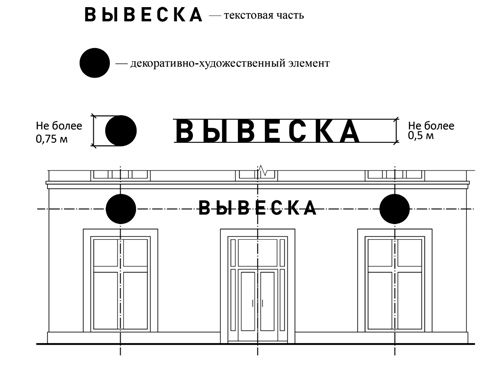
3. Organizations, individual entrepreneurs place information structures on flat sections of the facade, free from architectural elements, exclusively within the area of the external surfaces of the object, corresponding to the physical dimensions of the premises occupied by these organizations, individual entrepreneurs (clause 14 of the Rules).
When placing signboards of several organizations, individual entrepreneurs on one facade of an object at the same time, these signs are placed in one high-rise row on a single horizontal line (at the same level, height) (paragraph 15 of the Rules).
![]()
4. If the premises are located in the basement or basement floors of objects and there is no possibility of placing information structures (signs) in accordance with the requirements of the first paragraph of this paragraph, the signs can be placed above the windows of the basement or basement floor, but not lower than 0.60 m from ground level to the bottom edge of the wall structure. In this case, the sign should not protrude from the plane of the facade by more than 0.10 m (paragraph 18.1 of the Rules).
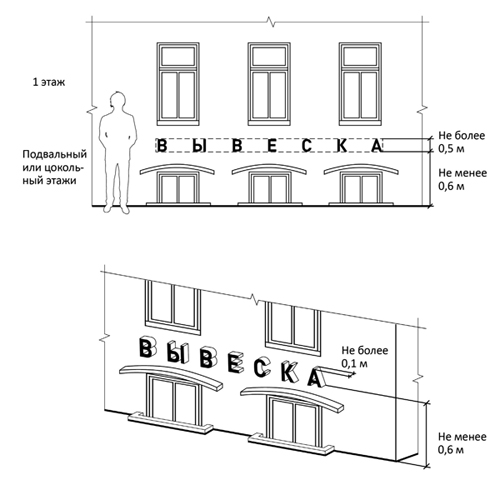
5. The maximum size of wall structures placed by organizations, individual entrepreneurs on the external surfaces of buildings, structures, structures should not exceed:
Height - 0.50 m, except for the placement of a wall sign on the frieze;
In length - 70 percent of the length of the facade, corresponding to the premises occupied by these organizations, individual entrepreneurs, but not more than 15 m for a single structure (paragraph 18.2 of the Rules).
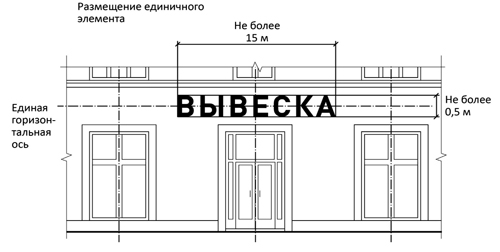
6. When placing a wall structure within 70 percent of the length of the facade in the form of a complex of identical interconnected elements (information field (text part) and decorative and artistic elements), the maximum size of each of these elements cannot exceed 10 m in length (clause 18.2 of the Rules) ...
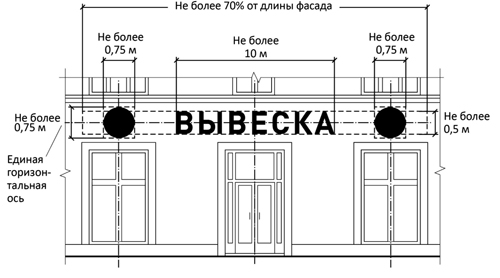
7. The maximum size of information structures containing information about the range of dishes, drinks and other food products offered when they provide these services, including indicating their weight / volume and price (menu), should not exceed:
Height - 0.80 m;
In length - 0.60 m (clause 18.2 of the Rules).
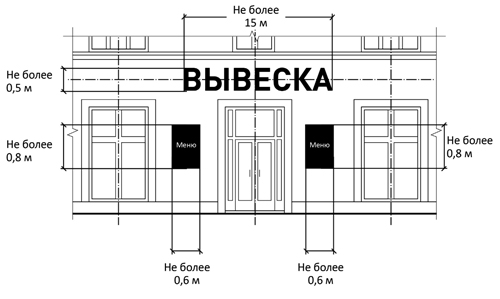
8. If there is a frieze on the facade of the object, the wall structure is placed exclusively on the frieze, over the entire height of the frieze (paragraph 18.3 of the Rules).

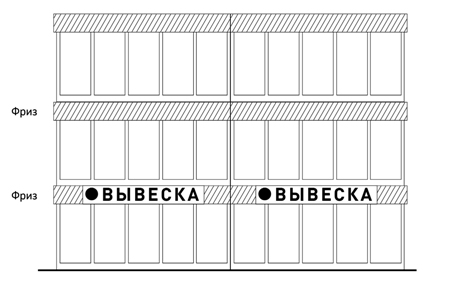
9. If there is a visor on the facade of the object, the wall structure can be placed on the frieze of the visor, strictly within the dimensions of the said frieze.
It is forbidden to place a wall structure directly on the structure of the visor (paragraph 18.3 of the Rules).

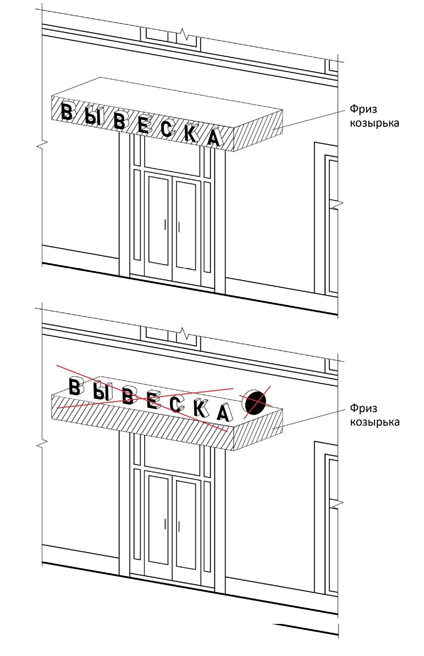
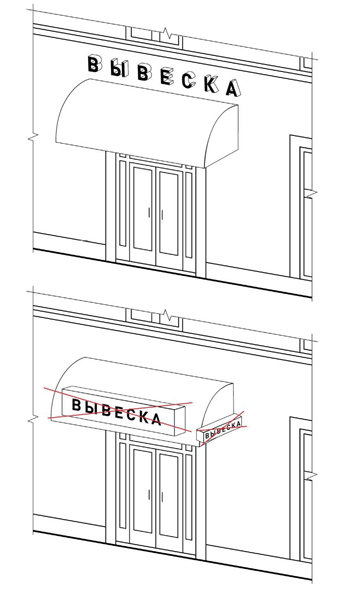
10. The information field of wall structures placed on the facades of objects that are objects of cultural heritage, identified objects of cultural heritage, or objects built before 1952 inclusive, must be made of individual elements (letters, designations, decorative elements, etc.) without using opaque base for their fastening (paragraph 18.4 of the Rules).
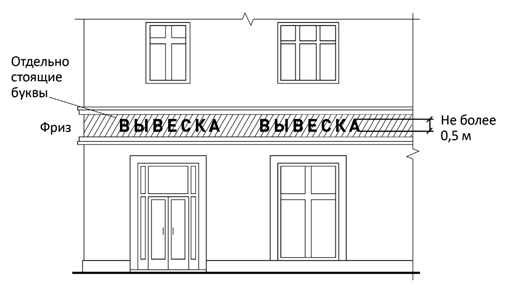
11. Cantilever structures are located in the same horizontal plane of the facade, near arches, at the borders and outer corners of buildings, structures, structures.
The distance between the cantilever structures cannot be less than 10 m (paragraph 19.1 of the Rules).
The distance from the ground level to the lower edge of the cantilever structure must be at least 2.50 m (paragraph 19.1 of the Rules).
The cantilever structure should not be more than 0.20 m from the edge of the facade, and its extreme point of the front side should not be more than 1 m from the plane of the facade. The cantilever structure may not exceed 1 m in height (clause 19.2 of the Rules).
If there are wall structures on the facade of the object, the cantilever structures are located with them on a single horizontal axis (clause 19.4 of the Rules).

12. The maximum parameters (dimensions) of cantilever structures placed on the facades of objects that are objects of cultural heritage, identified objects of cultural heritage, as well as objects built before 1952, inclusive, should not exceed 0.50 m in height and 0.50 m - in width (clause 19.3 of the Rules).

13. Showcase constructions are placed in the showcase, on the outside and / or on the inside of the objects showcase glazing.
The maximum size of showcase structures (including electronic media - screens) placed in the showcase, as well as on the inside of the showcase glazing, should not exceed half the height of the showcase glazing and half the length of the showcase glazing (clause 20.1 of the Rules).
When placing a sign in a showcase (from its inner side), the distance from the showcase glazing to the showcase structure must be at least 0.15 m (clause 20.4 of the Rules).
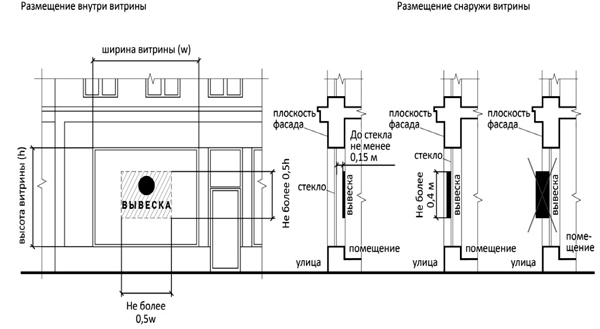
14. The parameters (dimensions) of the sign placed on the outside of the showcase should not exceed 0.40 m in height, in length - the length of the showcase glazing (clause 20.2 of the Rules).
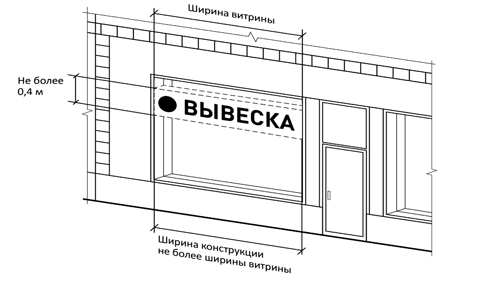
15. Information structures (signs) placed on the outside of the showcase must not go beyond the plane of the facade of the facility (paragraph 20.2 of the Rules).
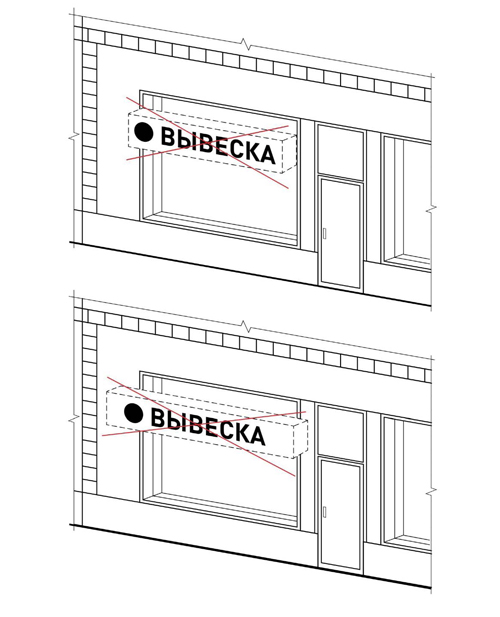
16. Directly on the glazing of the showcase, it is allowed to place the information structure (sign) provided for in clause 3.5.1 of these Rules in the form of individual letters and decorative elements. In this case, the maximum size of the letters of the sign placed on the glass of the showcase should not exceed 0.15 m in height (clause 20.3 of the Rules).

17. Only one information structure can be placed on the roof of one object (clause 21.1 of the Rules).
The design of signs allowed for placement on the roofs of buildings, structures, structures are three-dimensional symbols that can be equipped exclusively with internal lighting (paragraph 21.4 of the Rules).
The length of the signs installed on the roof of the facility may not exceed half the length of the facade in relation to which they are placed (paragraph 21.6 of the Rules).
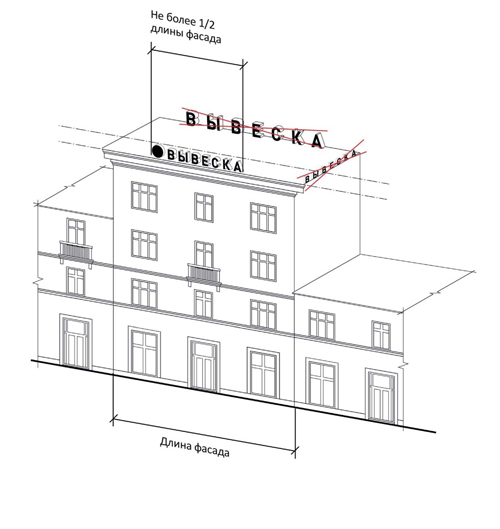
18. The height of information structures (signboards) placed on the roofs of buildings, structures, structures must be (paragraph 21.5 of the Rules):
a) no more than 0.80 m for 1-2-storey buildings;
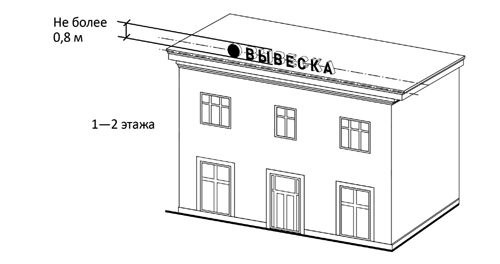
b) no more than 1.20 m for 3-5-storey buildings;
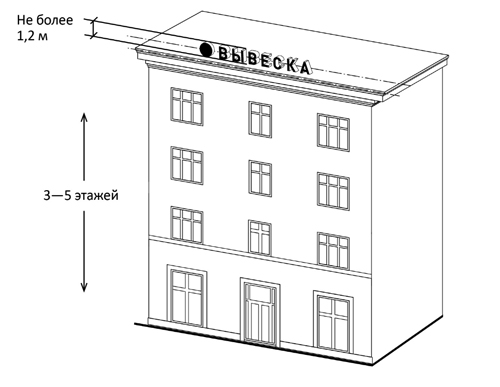
c) no more than 1.80 m for 6-9-storey buildings;
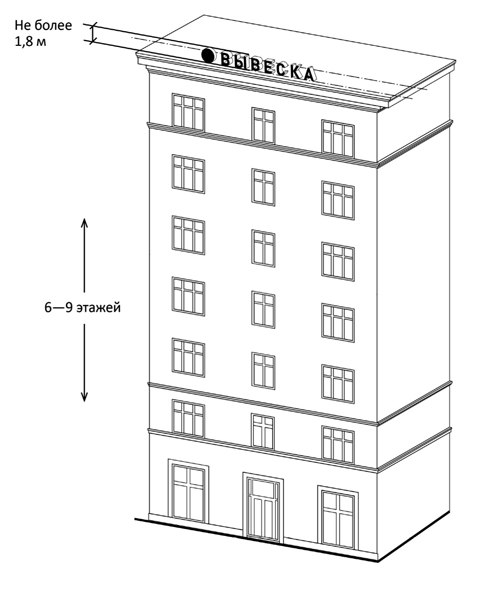
d) no more than 2.20 m for 10-15-storey buildings;
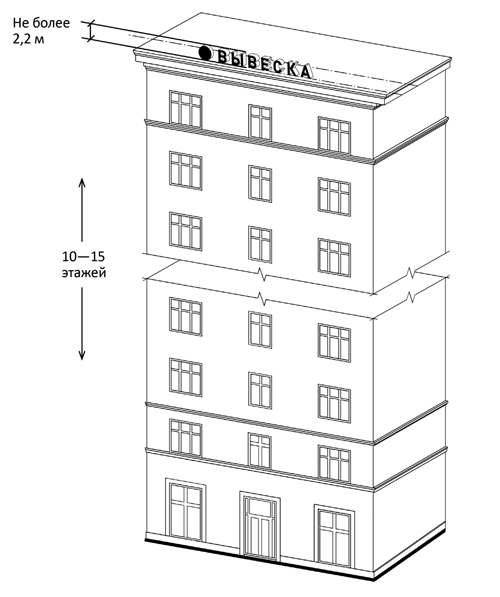
e) no more than 3 meters - for objects with 16 or more floors.
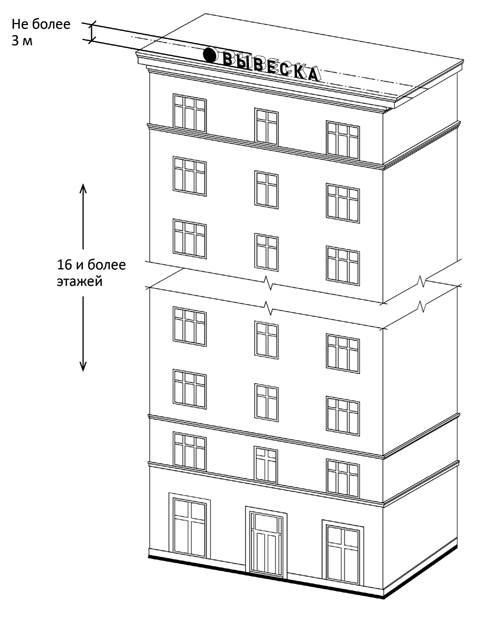
19. Parameters (dimensions) of information structures (signs) placed on the stylobate part of the object are determined depending on the number of storeys in the stylobate part of the object in accordance with the requirements of clauses 20.5 and 20.6 of these Rules (clause 21.7 of the Rules).
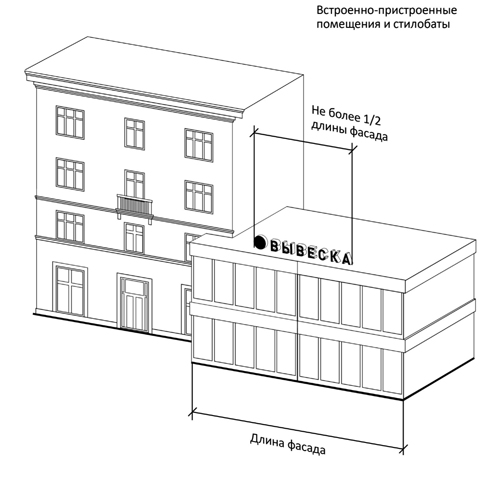
20. It is prohibited to place information structures (signs) on the roofs of buildings, structures, structures that are cultural heritage sites, identified cultural heritage sites, as well as sites built before 1952 inclusive (clause 21.8 of the Rules).
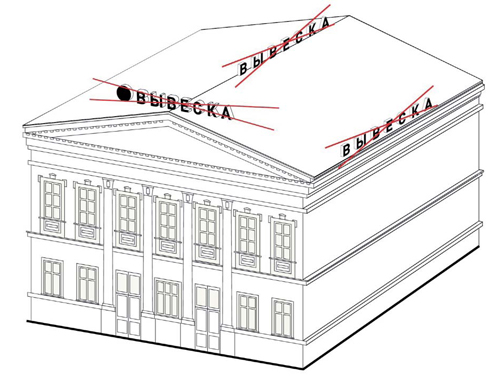
FORBIDDEN
21. Violation of the geometric parameters of signs (paragraph 10.1 of the Rules).
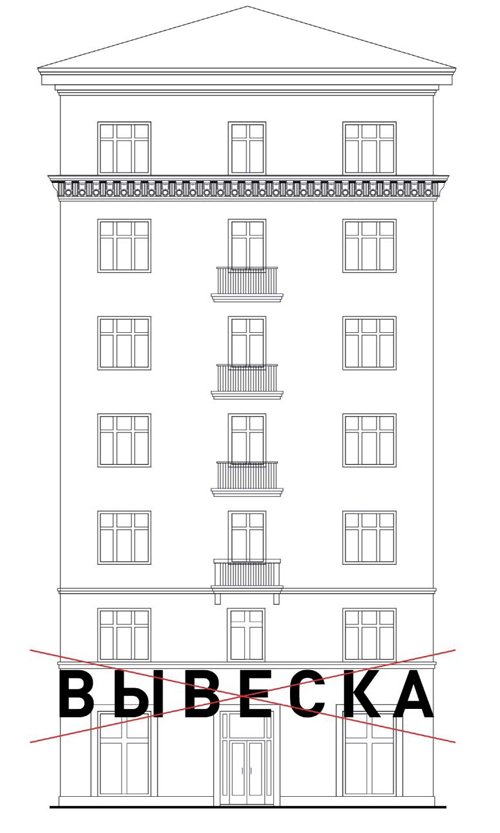
22. Violation of the requirements for locations (clause 10.1 of the Rules).

23. Vertical arrangement of letters (clause 10.1 of the Rules).
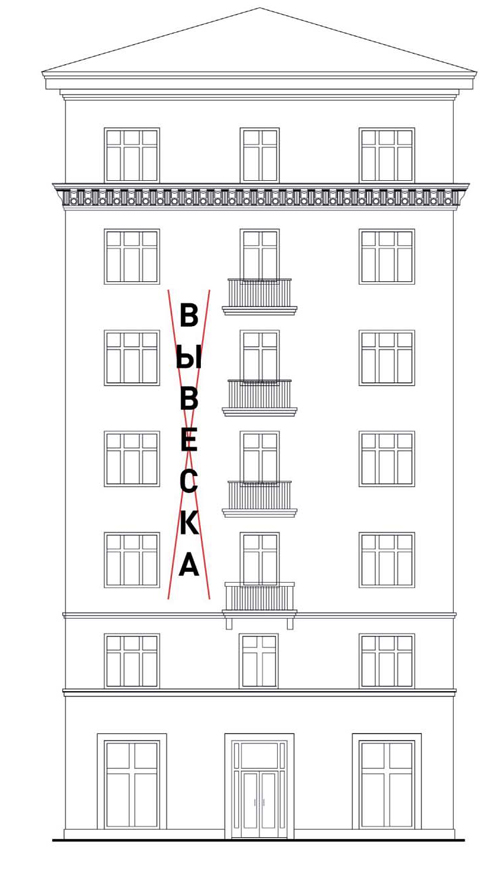
24. Placement on the visor (clause 10.1 of the Rules).
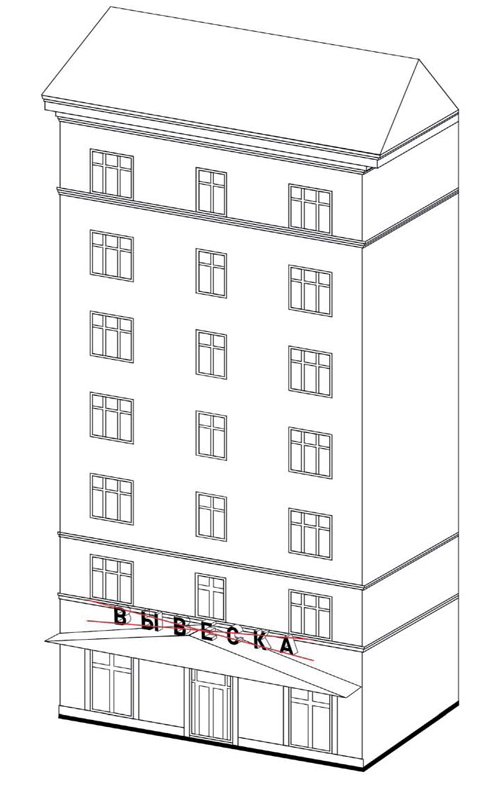
25. Full overlapping of window and door openings, as well as stained-glass windows and shop windows (clause 10.1 of the Rules).
Placing signs in window openings (clause 10.1 of the Rules).

26. Placement of signs within the boundaries of residential premises, including on the blind ends of the facade (clause 10.1 of the Rules).

27. Placing signs on roofs, loggias and balconies (clause 10.1 of the Rules).
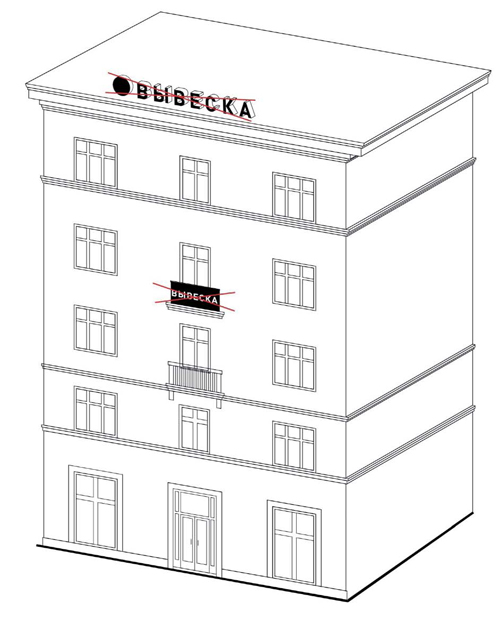
28. Placing signs on the architectural details of the facades (clause 10.1 of the Rules).
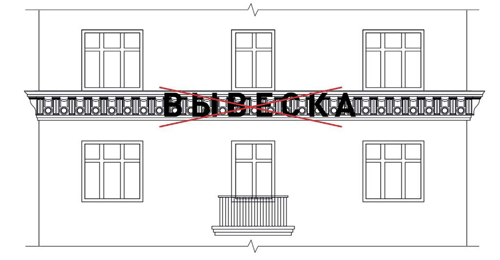
29. Placing signs near memorial plaques (Clause 10.1 of the Rules).
![]()
30. Overlapping signs of street names and house numbers (paragraph 10.1 of the Rules)
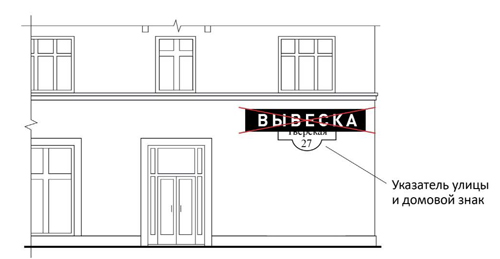
31. Painting and coating with decorative films of the surface of glass windows, replacement of glass windows with light boxes (clause 10.1 of the Rules).

32. Placement of cantilever signs at a distance of less than 10 m from each other (paragraph 10.1 of the Rules).
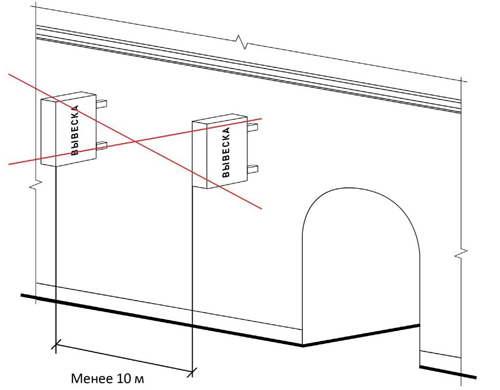
33. Placing signs on the enclosing structures of seasonal (summer) cafes at stationary catering establishments (clause 10.1 of the Rules).
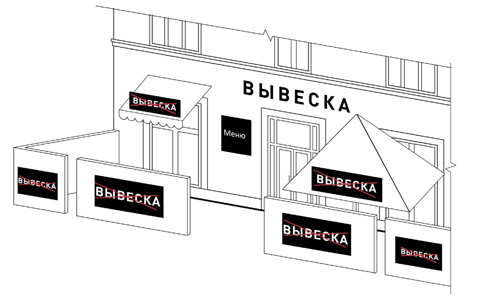
34. Placement of signs in the form of free-standing collapsible (folding) structures - pillars (clause 10.4 of the Rules).
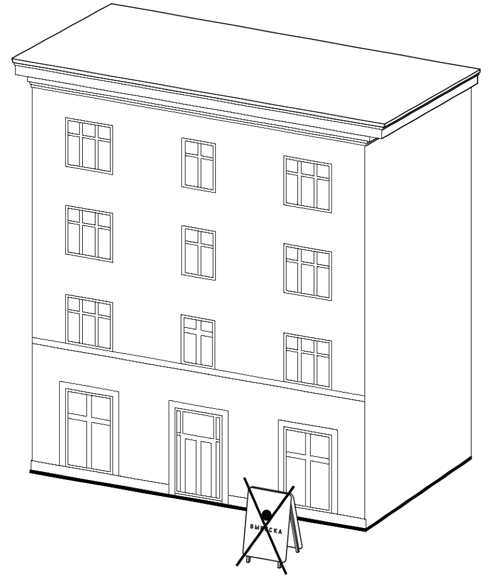
Administrative regulations for the provision of public services of the city of Moscow "Coordination of a design project for placing a sign"
1. General Provisions
1.1. These Administrative Regulations for the provision of public services of the city of Moscow "Coordination of a design project for placing a sign" establishes the composition, sequence and timing of administrative procedures (actions) and (or) decision-making on the provision of public services, carried out at the request (application) of a legal entity, an individual entrepreneur or their authorized representatives (hereinafter - the Regulation).
1.2. Administrative procedures and (or) actions established by this Regulation are carried out using the information from the Basic Register of information required for the provision of public services in the city of Moscow (hereinafter referred to as the Basic Register), and in accordance with the Uniform Requirements for the provision of public services in the city of Moscow, established The Moscow Government (hereinafter referred to as the Uniform Requirements).
1.3. From September 1, 2014, it is possible to receive state services in electronic form using the Portal of state and municipal services (functions) of the city of Moscow (hereinafter referred to as the Portal).
1.4. From October 1, 2014, the receipt of public services is possible only in electronic form using the Portal.
2. Standard for the provision of public services
2.1. Public service name
Coordination of a design project for placing a sign (hereinafter - a public service).
2.2. Legal basis for the provision of public services
The provision of public services is carried out in accordance with:
Federal Law of July 27, 2010 No. 210-FZ "On the organization of the provision of state and municipal services";
Resolution of the Moscow Government dated November 15, 2011 No. 546-PP "On the provision of state and municipal services in the city of Moscow";
Resolution of the Moscow Government dated November 7, 2012 No. 633-PP “On approval of the Regulations on the Committee for Architecture and Urban Planning of the City of Moscow”.
2.3. The name of the executive authority of the city of Moscow providing the public service, other executive authorities involved in the provision of the public service
2.3.1. The authority to provide public services is exercised by the Committee for Architecture and Urban Planning of the city of Moscow (hereinafter referred to as the Committee).
2.3.2. For purposes related to the provision of public services, documents and information obtained in the process of interdepartmental information interaction with:
Federal Tax Service;
Federal Service for State Registration, Cadastre and Cartography;
Department of Cultural Heritage of the city of Moscow;
Department of city property of the city of Moscow.
2.4. Applicants
2.4.1. Legal entities and individual entrepreneurs can act as applicants.
2.4.2. The interests of the applicants specified in clause 2.4.1 of these Regulations may be represented by other persons authorized by the applicant in the prescribed manner.
2.4.3. When submitting an application in electronic form, the Applicants can be legal entities and individual entrepreneurs who have been registered in the prescribed manner on the Portal of state and municipal services (functions) of the city of Moscow.
2.5. Documents required for the provision of public services
The provision of public services is carried out on the basis of the following documents (information):
2.5.1. Documents submitted by the applicant:
The request is made in accordance with Appendix 1 to these Regulations.
2.5.1.3. A document confirming the authority of the applicant's representative - in a copy upon presentation of the original (in case of applying for the provision of public services by an authorized representative of the applicant) (in case of personal appearance before October 1, 2014).
2.5.1.4. Documents of title confirming the applicant's property rights to the building, structure, structure, premises, which is the location (place of business) of the organization, individual entrepreneur, placing the sign (if there are documents that are not subject to state registration).
2.5.1.5. Documents certifying (establishing) the applicant's rights to a land plot on which a building, structure, structure is located, which are the location (place of business) of an organization, an individual entrepreneur, placing a free-standing signboard, if the right to a land plot in accordance with the legislation of the Russian Federation The Federation is recognized as having arisen regardless of its registration in the Unified State Register of Rights to Real Estate and Transactions with It (provided in the absence of information on rights to a land plot in the Unified State Register of Rights to Real Estate and Transactions with It) (if necessary).
2.5.1.6. Technical inventory documents - floor plan of the premises issued by an authorized organization.
2.5.1.7. The design project for the placement of the sign approved by the applicant, prepared and executed in accordance with the requirements in accordance with Appendix 2 to these Regulations.
2.5.2. Documents received by an authorized official of the Committee using interdepartmental information interaction, including through access to the information of the Base Register:
2.5.2.1. Extract from the Unified State Register of Legal Entities (for legal entities).
2.5.2.2. Extract from the Unified State Register of Individual Entrepreneurs (for individual entrepreneurs).
2.5.2.3. A document confirming the applicant's registered right to a building, structure, structure, premises, which is the location (place of business) of an organization, an individual entrepreneur, placing a sign (if such a document is subject to state registration).
2.5.2.4. Documents certifying (establishing) the applicant's rights to a land plot on which a building, structure, structure is located, which is the location (place of business) of an organization, an individual entrepreneur, placing a sign (if information on rights to a land plot is contained in a Single the state register of rights to real estate and transactions with it).
2.5.2.5. A lease agreement for a building, structure, structure, if the specified document is issued by the Department of City Property of the city of Moscow.
2.5.3. The applicant has the right to submit the documents specified in clause 2.5.2 of these Regulations on his own initiative.
2.5.4. The list of documents required for the provision of public services is exhaustive.
2.5.5. When submitting a request in electronic form using the Portal, the applicant shall attach to the request electronic images of the documents specified in clauses 2.5.1.4 - 2.5.1.7, signed in the prescribed manner by the applicant's electronic signature.
2.6. Services necessary and obligatory for the provision of public services
The service necessary and obligatory for the provision of public services is the provision of technical inventory documents - the floor plan of the premises.
2.7. The term for the provision of public services
2.7.1. The total period for the provision of public services includes the period of interdepartmental information interaction between executive authorities and organizations in the process of providing public services and cannot exceed 15 working days.
2.7.2. The term for the provision of public services begins to be calculated on the next day after the registration of the request.
2.7.3. The term for registering a request and documents required for the provision of a public service cannot exceed:
2.7.3.1. In case of personal contact - 30 minutes;
2.7.3.2. When submitting a request using the Portal - one business day.
2.8. Refusal to accept documents required for the provision of public services
2.8.1. The grounds for refusing to accept documents required for the provision of public services are:
Application of the applicant for obtaining a public service, the provision of which is not carried out by the Committee;
Submission by the applicant of an incomplete set of documents provided for in paragraph 2.5.1 of these Regulations;
Inconsistency of the submitted request and other documents with the requirements established legal acts Russian Federation, legal acts of the city of Moscow, Uniform requirements and these Regulations;
Submission of invalid documents by the applicant;
Submission by the applicant of documents containing inaccurate and (or) contradictory information;
Submission of an application on behalf of the applicant by an unauthorized person.
2.8.2. Additional grounds for refusing to accept documents required for the provision of a public service when providing a public service in electronic form using the Portal are:
2.8.2.1. Incorrect filling of required fields in the online application form.
2.8.2.2. The presence of conflicting information in the submitted documents and in the online statement.
2.8.2.3. Submission by the applicant of documents not signed in accordance with the established procedure.
2.8.2.4. The request and documents in electronic form are signed using an electronic signature that does not belong to the applicant.
2.8.3. The list of grounds for refusing to accept documents required for the provision of public services, established by clauses 2.8.1 and 2.8.2 of these Regulations, is exhaustive.
2.8.4. A written decision on refusal to accept documents required for the provision of public services is drawn up at the request of the applicant, signed by an authorized official and issued (sent) to the applicant, indicating the reasons for the refusal no later than three working days from the date of receipt of the documents from the applicant.
2.8.5. The decision to refuse to accept a request submitted using the Portal is signed by an authorized official using an electronic signature and sent to the applicant indicating the reasons for the refusal to the subsystem " Personal Area»Of the Portal no later than three working days from the date of registration of the request.
2.9. Suspension of the provision of public services
There are no grounds for suspending the provision of public services.
2.10. Refusal to provide a public service
2.10.1. The grounds for refusal to provide a public service are:
Inconsistency of the submitted request and other documents with the requirements established by the legal acts of the Russian Federation, the legal acts of the city of Moscow, the Unified Requirements, these Regulations, if these circumstances were established by the Committee in the process of processing the request submitted by the applicant and other documents;
Loss of the validity of the submitted documents, if the specified circumstances were established by the Committee in the process of processing the request submitted by the applicant and other documents;
Submission of documents containing contradictory and (or) inaccurate information, if the specified circumstances were established by the Committee in the process of processing the request and documents submitted by the applicant;
Inconsistency of the design project for the placement of the sign submitted by the applicant with the requirements established by Appendix 2 to these Regulations;
Inconsistency of the design project for the placement of a sign submitted by the applicant with the requirements of the Rules for the placement and maintenance of information structures in the city of Moscow, established by the Moscow Government, with the requirements of the Architectural and artistic concepts of the external appearance of streets, highways and territories of the city of Moscow;
Documents or information obtained through interdepartmental information interaction, including the use of the Basic Register of Information, contradict the documents or information submitted by the applicant;
The lack of documents or information from authorities and organizations, requested through interdepartmental information interaction, including the use of the Basic Register of Information;
Inconsistency of the submitted documents with the requirements of the legislation on cultural heritage objects, confirmed by a motivated refusal by the Department of Cultural Heritage of the city of Moscow to approve the documents submitted by the applicant - when placing signs on the external surfaces of buildings, structures, structures that are cultural heritage objects, identified cultural heritage objects;
The absence of architectural and artistic elements on the facades of objects that impede the placement of signs.
2.10.2. The list of grounds for refusal to provide public services, established by clause 2.10.1 of these Regulations, is exhaustive.
2.10.3. The decision to refuse to provide a public service is signed by the Chairman of the Committee or an official authorized by him and is issued (sent) to the applicant indicating the reasons for the refusal no later than the next working day from the moment of the decision to refuse to provide the public service.
2.10.4. The decision to refuse to provide a public service upon a request submitted in electronic form using the Portal, indicating the reasons for the refusal, is signed by the Chairman of the Committee or an official authorized by him using an electronic signature and sent to the applicant in the "personal account" subsystem of the Portal no later than the next working day from the day making a decision to refuse to provide a public service.
2.11. The result of the provision of public services
2.11.1. The result of the provision of public services is:
Notification of approval of a design project for placing a sign;
Refusal to provide a public service.
2.11.2. A document and (or) information confirming the provision of a public service (including a refusal to provide a public service) may be:
Issued to the applicant (representative of the applicant) in the form of a paper document upon the applicant's personal appearance in the Committee;
Sent to the applicant in the form electronic document, signed in accordance with the established procedure, in the subsystem "personal cabinet" of the Portal when providing public services in electronic form using the Portal.
2.11.3. The form and method of obtaining a document and (or) information confirming the result of the provision of a public service, including a refusal to provide a public service, are indicated by the applicant in the request.
The issuance of the result of the provision of a public service in the form of an electronic document using the Portal does not deprive the applicant of the right to receive the specified result in the form of a paper document.
2.11.4. Information on the final results of the provision of public services is entered into the Register of design projects approved by the Committee for Architecture and Urban Planning of the city of Moscow (hereinafter referred to as the Register), which is an integral part of the Basic Register, within one working day from the moment of making a decision on the provision of public services in the following composition :
Applicant (legal entity - name of the organization, OGRN, TIN; individual entrepreneur - last name, first name, patronymic, OGRNIP, TIN);
Date of issue of approval;
Address of the object;
Design project.
2.11.5. Entering information about the end result of the provision of public services in the Register does not deprive the applicant of the right to receive the specified result in the form of a document on paper or in electronic form, certified by the electronic signature of an authorized official.
2.11.6. The information contained in the Register is open and available for interested parties to familiarize with it and is subject to placement on the information and telecommunications network Internet using the automated information system "Citywide Open Data Platform", except for cases when in the interests of preserving the state, official or other secrets protected by law, such access should be limited in accordance with the legislation of the Russian Federation.
2.12. Payment for the provision of public services.
Payment for the provision of services that are necessary and mandatory for the provision of public services
2.12.1. The provision of public services is free of charge.
2.12.2. The services necessary and obligatory for the provision of public services are provided at the expense of the applicant (Resolution of the Moscow Government dated August 15, 2011 No. 359-PP "On services that are necessary and obligatory for the provision of public services").
2.13. Indicators of accessibility and quality of public services
The quality and availability of public services are characterized by the following indicators:
The term for the provision of public services is 15 working days;
Waiting time in the queue when submitting a request - no more than 15 minutes;
The deadline for registering an applicant's request is no more than 30 minutes with a personal appeal and no more than 1 working day when submitting a request using the Portal;
Waiting time in the queue upon receipt of the result of the provision of public services - no more than 15 minutes;
The waiting time in the queue when submitting a request by appointment is 15 minutes.
2.14. Information procedure
on the provision of public services
2.14.1. Information about the provision of public services is posted:
On the portal;
On the official website of the Committee in the information and telecommunications network "Internet";
At the stands in the premises of the Committee.
2.14.2. When providing a public service in electronic form using the Portal, the applicant has the opportunity to receive information about the progress of the request in the "personal account" subsystem of the Portal.
3. Composition, sequence and timing of administrative procedures, requirements for the order of their implementation, especially the implementation of administrative procedures in electronic form
Sequence of administrative procedures
3.1. The provision of public services includes the following administrative procedures:
3.1.1. Acceptance (receipt) and registration of requests and other documents required for the provision of public services.
3.1.2. Processing of documents (information) required for the provision of public services.
3.1.3. Formation of the result of the provision of a public service with the introduction of information about the end result of the provision of a public service in the Register information.
3.1.4. Issuance (direction) to the applicant of documents and (or) information confirming the result of the provision of public services, including refusal to provide public services.
3.2. Acceptance (receipt) and registration of a request and other documents (information) required for the provision of public services:
3.2.1. The basis for starting the execution of the administrative procedure is the receipt from the applicant of a request and other documents necessary for the provision of public services. In the case of submitting a request in electronic form using the Portal, the basis for starting the execution of the administrative procedure is the registration of the request on the Portal.
3.2.2. The official responsible for the implementation of the administrative procedure is a specialist of the structural unit of the Committee (hereinafter - the official responsible for receiving documents).
3.2.3. The official responsible for accepting documents:
Carries out the acceptance and registration of documents submitted by the applicant, in accordance with the Uniform Requirements;
If there are grounds specified in clause 2.8 of these Regulations, issues (sends) the applicant a refusal to accept documents necessary for the provision of public services;
Not later than one day following the day of registration of the application, he sends the generated set of documents to the appropriate structural unit of the Committee responsible for processing documents.
3.2.4. The maximum time to complete the administrative procedure is one business day.
3.2.5. The result of the administrative procedure is the sending of the formed set: the request and the documents submitted by the applicant to the structural unit of the Committee responsible for processing documents, and if there are grounds for refusing to accept the documents necessary for the provision of public services, issuing (sending) the refusal to the applicant. acceptance of documents required for the provision of public services.
3.3. Processing of documents (information) required for the provision of public services:
3.3.1. The basis for starting the execution of the administrative procedure is the receipt by the official authorized to perform the administrative procedure, the documents received from the applicant.
3.3.2. The official responsible for the implementation of the administrative procedure is a specialist of the structural unit of the Committee (hereinafter - the official responsible for processing documents (information).
3.3.3. The official responsible for processing documents (information):
Analyzes the generated set of documents submitted by the applicant;
Analyzes the design project for placing a sign for compliance with the established requirements;
Carries out interdepartmental information interaction with the executive authorities specified in clause 2.3.2 of these Regulations in order to obtain documents and information necessary for the provision of public services, including obtaining approval from the Department of Cultural Heritage of the city of Moscow - upon approval of a design project for placing information structures (signage ) on the outer surfaces of a building, structure, structure that is an object of cultural heritage, an identified object of cultural heritage.
The period for consideration by the Department of Cultural Heritage of the City of Moscow of the documents submitted by the applicant, including the period for sending the decision taken as a result of consideration of the documents to the Committee, is 7 working days from the date of sending these documents by the Committee for consideration to the Department of Cultural Heritage of the City of Moscow.
If the Committee does not receive the decision of the Department of Cultural Heritage of the City of Moscow, adopted based on the results of consideration of the received documents, after the expiry of the period established for approval, the documents submitted by the applicant are considered approved by the Department of Cultural Heritage of the City of Moscow.
The organization of registration and consideration of documents received by the Department of Cultural Heritage of the City of Moscow is carried out in accordance with the procedure established by a legal act of the Department of Cultural Heritage of the City of Moscow;
If there are grounds specified in clause 2.10 of these Regulations, prepares a draft decision on the refusal to provide a public service.
3.3.4. The maximum time to complete the administrative procedure is 10 working days.
3.3.5. The result of the administrative procedure is the transfer of the design project for the placement of a sign or a draft decision on refusal to provide a public service (if there are grounds for refusing to provide a public service), considered for compliance with the established requirements, to an official of the Committee responsible for the formation of the result of providing a public service.
3.4. Formation of the result of the provision of a public service with the introduction of information about the end result of the service in the composition of the Register information:
3.4.1. The basis for starting the implementation of the administrative procedure is the receipt by the official responsible for the formation of the result of the provision of the public service (hereinafter - the official responsible for the formation of the result), the draft of the corresponding decision.
3.4.2. The official responsible for the formation of the result is an authorized specialist of the structural unit of the Committee.
3.4.3. The official responsible for shaping the result:
Submits for approval to the authorized official of the Committee a design project for placing a sign or a draft decision on refusal to provide a public service;
Ensures that information about the end result of the provision of public services is entered into the information of the Register;
Submits a notice of approval of a design project for placing a sign or a decision to refuse to provide a public service in the prescribed manner to the appropriate structural unit of the Committee.
3.4.4. The maximum period for completing the administrative procedure, including for a request submitted in electronic form using the Portal, is three working days.
3.4.5. The result of the administrative procedure is the sending of a notice of approval of the design project for placing a sign or a decision to refuse to provide a public service in the prescribed manner to a specialist of the structural unit of the Committee for issuance to the applicant and entering the relevant information into the Register.
3.5. Issuance (direction) to the applicant of documents confirming the result of the provision of public services, including refusal to provide public services:
3.5.1. The basis for starting the implementation of the administrative procedure is the receipt by the official responsible for the implementation of the administrative procedure, an agreed design project for placing a sign or a signed decision to refuse to provide a public service.
3.5.2. The official responsible for the implementation of the administrative procedure is a specialist of the structural unit of the Committee, authorized to issue documents (hereinafter referred to as the official responsible for issuing documents).
3.5.3. The official responsible for issuing (sending) documents issues (sends) to the applicant an agreed design project for placing a sign or a decision to refuse to provide a public service.
3.5.4. The maximum time to complete the administrative procedure, including for an electronic request using the Portal, is one business day.
3.5.5. The result of the administrative procedure is the issuance (direction) or provision, using the Portal, to the applicant of documents confirming the result of the provision of the public service, including the refusal to provide the public service.
4. Forms of control over the implementation of these Regulations
4.1. Control over the implementation of these Regulations is carried out by the Committee and the Main Control Department of the City of Moscow in the forms established by the Government of Moscow.
4.2. The current control over the observance and implementation by the officials of the Committee of the provisions of these Regulations and other legal acts establishing the requirements for the provision of public services, as well as their decision-making, is carried out by the Chairman of the Committee and his authorized officials.
4.3. The list of officials exercising current control is established by a legal act of the Committee.
5. Pre-trial (extrajudicial) procedure for appealing decisions and actions (inaction) of the Committee, officials of the Committee
The applicant may report a violation of his rights and legitimate interests, unlawful decisions, actions (inaction) of the Committee, officials of the Committee, violation of the provisions of these Regulations, incorrect behavior or violation of official ethics by phone, mailing addresses, e-mail addresses posted on the official website of the Committee in the information and telecommunication network "Internet", the Portal in the manner prescribed by the legal acts of the Russian Federation, legal acts of the city of Moscow.
Annex 1
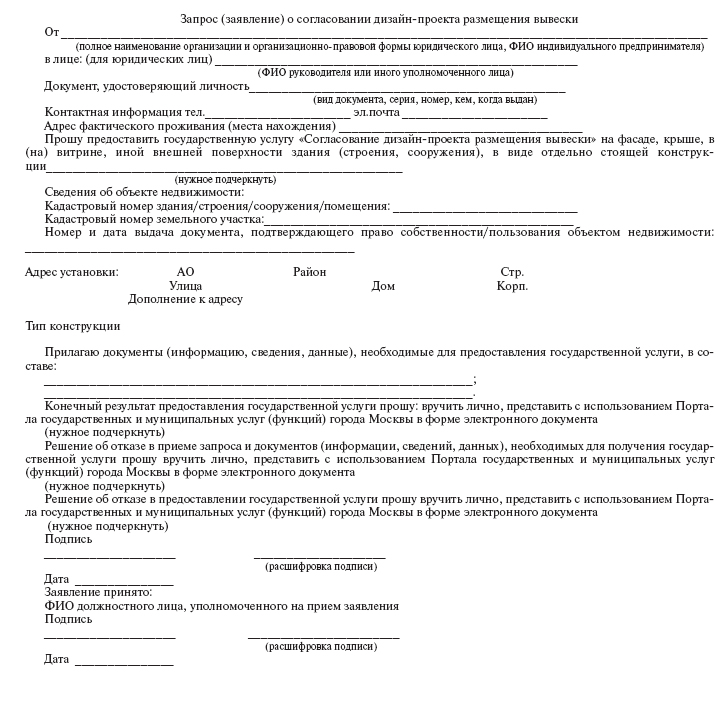
Appendix 2
to the Administrative Regulations for the Provision of
public service of the city of Moscow
"Coordination of a design project for placing a sign"
Requirements for a design project for placing a sign in the city of Moscow
1. The design project for the placement of the sign includes text and graphic materials.
2. Text materials are drawn up in the form of an explanatory note and include:
Information about the address of the object;
Information about the type of design of the sign, the place of its placement;
Information about the method of lighting the sign;
Signboard parameters.
3. Graphic materials of the design project when placing a sign on the outer surfaces of buildings, structures, structures include:
Drawings of all facades of the object (orthogonal, on which the signboard is supposed to be placed, indicating the location of the sign, its parameters (length, width, height) and type of structures);
Photomontage (graphic drawing of the sign in the place of its intended placement in the existing situation, indicating the size). It is carried out in the form of a computer drawing of the design of a sign on a photograph, observing the proportions of the object being placed;
Photos of the intended location of the sign, taken no more than one month before applying for a public service, in the amount of at least 3 color photographs (in a format of at least 10 by 15 and no more than 13 by 18). Photos of the object must be printed with a resolution of at least 300 dpi, with respect to contrast and color rendition. Photo fixation must be made from two opposite sides (to the left and to the right of the intended location of the sign) at a distance of 40-50 meters and in the center from the required distance, capturing the location of the sign and other structures placed on the entire plane of the outer surfaces of the building, structure, structure, as well as adjacent building facades.
4. Additional requirements for a design project for placing a sign, provided in electronic form (hereinafter referred to as an electronic document):
4.1. The formation of an electronic document should be carried out using a single PDF file format (version 1.7).
4.2. An electronic document is prepared by saving from vector programs.
4.3. The composition of the materials of the generated electronic document and the form of their submission (design of books and drawings) should be such that when they are printed out, the production of a full paper version of the document is ensured - without any additional actions on the part of the user.
4.4. Electronic images are saved in color mode with a resolution of at least 300 dpi.
4.5. The saved electronic image should not have the effect of image deformation.
4.6. Images are rotated to a horizontal level. The image is cleared of debris, straightened, shadows are removed, the edges are cropped.
4.7. The number of images must match the number of sheets in the original document. The presence on electronic images of black fields at the edges of the image more than 1 mm, stripes, spots, blurring of the image that affect readability and are absent on the original, violation of the order of the pages of the document is not allowed.
Amendments to the legal acts of the city of Moscow
1. To amend the Decree of the Moscow Government dated February 24, 2010 No. 157-PP "On the Powers of the Territorial Executive Bodies of the City of Moscow" (as amended by the Resolutions of the Moscow Government dated May 18, 2010 No. 403-PP, dated October 12, 2010 No. 938-PP, dated June 7, 2011 No. 254-PP, dated June 16, 2011 No. 269-PP, dated June 28, 2011 No. 285-PP, dated July 19, 2011 No. 330-PP, of August 2, 2011 No. 347-PP, of August 30, 2011 No. 396-PP, of October 25, 2011 No. 491-PP, of May 15, 2012 No. 208-PP, of May 15, 2012 No. 209-PP, dated May 22, 2012 No. 233-PP, dated June 15, 2012 No. 272-PP, dated June 18, 2012 No. 274-PP, dated July 3, 2012 No. 303-PP, dated October 25, 2012 No. 597-PP, dated November 7, 2012 No. 632-PP, dated November 13, 2012 No. 636-PP, dated December 26, 2012 No. 848-PP, dated February 15, 2013 No. 76-PP, dated March 28, 2013 No. 179-PP, dated April 16, 2013 No. 242-PP, dated June 13, 2013 No. 377-PP, dated August 13, 2013 No. 530-PP, dated 20 August 2013 No. 552-PP, dated September 6, 2013 No. 587-PP, dated 13 se November 2013 No. 606-PP, dated October 2, 2013 No. 661-PP, dated October 15, 2013 No. 684-PP, dated October 22, 2013 No. 701-PP, dated November 26, 2013 No. 758 -PP, dated December 11, 2013 No. 819-PP):
1.1. Appendix 1 to the resolution shall be supplemented with clause 2.1.25 as follows:
"2.1.25. Coordinates the work of district administrations on the dismantling of signs that do not meet the established requirements, their movement and storage, including the organization of special places for said storage. "
1.2. Appendix 2 to the resolution shall be supplemented with clauses 2.1.33 - 2.1.35 as follows:
"2.1.33. Identifies signs that do not meet the established requirements.
2.1.34. Organizes work on dismantling, moving and storing signboards that do not meet the established requirements. Organizes storage space for signs that do not meet the established requirements.
2.1.35. Organizes work on the restoration of the external surfaces of buildings, structures, structures on which dismantled signs were placed, in cases established by legal acts of the city of Moscow. "
2. To amend the Decree of the Government of Moscow dated June 8, 2010 No. 472-PP "On the implementation of orders of the Government of Moscow on the optimization of the system of providing public services on the principle of" one window "and shortening the time for preparing documents" (as amended by decrees of the Government of Moscow dated August 10, 2010 No. 705-PP, dated August 24, 2010 No. 735-PP, dated September 7, 2010 No. 770-PP, dated September 14, 2010 No. 795-PP, dated October 19, 2010 No. 943-PP, dated October 19, 2010 No. 949-PP, dated November 2, 2010 No. 993-PP, dated November 2, 2010 No. 1002-PP, dated December 7, 2010 No. 1049-PP, dated 14 December 2010 No. 1063-PP, dated March 29, 2011 No. 90-PP, dated April 7, 2011 No. 115-PP, dated June 7, 2011 No. 250-PP, dated June 28, 2011 No. 279 -PP, dated June 28, 2011 No. 285-PP, dated August 23, 2011 No. 386-PP, dated October 25, 2011 No. 495-PP, dated October 25, 2011 No. 508-PP, dated November 15 2011 No. 546-PP, dated November 22, 2011 No. 551-PP, dated December 6, 2011 No. 572-PP, dated February 2, 2012 No. 16-PP, dated 14 February 2012 No. 43-PP, dated February 16, 2012 No. 57-PP, dated February 21, 2012 No. 59-PP, dated March 27, 2012 No. 111-PP, dated March 28, 2012 No. 114 -PP, dated March 28, 2012 No. 115-PP, dated April 3, 2012 No. 128-PP, dated April 17, 2012 No. 147-PP, dated April 17, 2012 No. 148-PP, dated April 17 2012 No. 149-PP, dated April 25, 2012 No. 186-PP, dated May 15, 2012 No. 199-PP, dated May 15, 2012 No. 200-PP, dated May 15, 2012 No. 211- PP, dated May 22, 2012 No. 231-PP, dated July 25, 2012 No. 354-PP, dated July 25, 2012 No. 356-PP, dated October 5, 2012 No. 542-PP, dated October 5, 2012 No. 543-PP, dated December 12, 2012 No. 713-PP, dated December 26, 2012 No. 840-PP, dated January 17, 2013 No. 2-PP, dated February 13, 2013 No. 58-PP , dated March 21, 2013 No. 161-PP, dated April 4, 2013 No. 211-PP, dated April 30, 2013 No. 274-PP, dated May 7, 2013 No. 285-PP, dated May 17, 2013 . No. 289-PP, dated May 17, 2013 No. 304-PP, dated June 11, 2013 No. 372-PP, dated July 10, 2013 No. 453-PP, dated August 6, 2013 No. 519-PP, dated August 14, 2013 No. 531-PP, dated September 3, 201 3, No. 583-PP):
2.1. The subsection "Committee for Architecture and Urban Planning of the City of Moscow (Moskomarkhitektura)" of the Section "Complex of Urban Development Policy and Construction of the City of Moscow" of Appendix 1 to the Resolution shall be supplemented with Clause 7 as amended in accordance with the Appendix to this Appendix.
2.2. Clause 2 of the subsection "Department of Mass Media and Advertising of the City of Moscow" of the section "Executive authorities that are not part of the city administration complexes" of Appendix 1 to the Resolution shall be declared invalid.
3. To amend the Decree of the Moscow Government dated February 16, 2011 No. 38-PP "On expenditure obligations of prefectures administrative districts of the city of Moscow for the financial support of activities not included in government programs of the city of Moscow "(as amended by resolutions of the Moscow Government dated May 4, 2011 No. 172-PP, dated May 16, 2011 No. 202-PP, dated February 19, 2013 No. 85-PP, dated November 26, 2013 No. 758 -PP):
3.1. Supplement the resolution with clause 1.24 as follows:
"1.24. Carrying out work on dismantling, moving and storing signboards that do not meet the established requirements, places for their storage, as well as work on restoring the external surfaces of buildings, structures, structures on which dismantled signs were placed. "
3.3. In clause 2 of the resolution, the words "in accordance with clause 1.24" shall be replaced by the words "in accordance with clause 1.25.
4. To amend the Decree of the Moscow Government dated February 22, 2011 No. 45-PP "On the Department of Mass Media and Advertising of the City of Moscow" (as amended by resolutions of the Moscow Government dated November 20, 2012 No. 657-PP, dated December 12, 2012 No. 714-PP, dated June 11, 2013 No. 373-PP, dated June 25, 2013 No. 405-PP):
4.1. In clauses 4.2.1, 4.2.22, 4.2.27, 4.2.29 of Appendix 1 to the Resolution, the words “and informational” shall be excluded.
4.2. Supplement with paragraph 4.2.39 as follows:
"4.2.39. On monitoring the implementation by the administrations of Moscow districts of the functions of organizing the dismantling of signboards that do not meet the established requirements. "
5. To amend the Decree of the Moscow Government dated November 7, 2012 No. 633-PP "On approval of the Regulations on the Committee for Architecture and Urban Planning of the City of Moscow" (as amended by resolutions of the Moscow Government dated December 12, 2012 No. 714-PP, dated 24 June 2013 No. 400-PP, dated August 14, 2013 No. 531-PP), excluding in clause 4.2.15.7 of the annex to the resolution the words “, as well as the approval of the Unified concepts of the external information design of shopping, entertainment centers, cinemas, theaters, circuses in the city of Moscow ".
6. To amend the Decree of the Government of Moscow dated March 14, 2013 No. 146-PP "On conducting an experiment to optimize the activities of certain state institutions of the city of Moscow and state unitary enterprises of the city of Moscow, operating in the field of urban economy of the city of Moscow" (as amended by resolutions Moscow Government dated June 4, 2013 No. 354-PP, dated August 28, 2013 No. 562-PP, dated October 2, 2013 No. 661-PP, dated October 10, 2013 No. 672-PP, dated November 25, 2013 No. 746-PP, dated December 3, 2013 No. 790-PP), supplementing the resolution with clause 2.2.1.15 as follows:
"2.2.1.15. Dismantling, moving and storing signboards that do not meet the established requirements. Carrying out work on the restoration of the external surfaces of buildings, structures, structures on which dismantled signs were placed, in cases established by legal acts of the city of Moscow. ".
Application
to Appendix 3
Amendments to Appendix 1 to the Resolution
Moscow Government dated June 8, 2010 No. 472-PP
Unified register of documents issued to applicants by executive authorities, state institutions and state unitary enterprises of the city of Moscow
|
№ p / p |
Title of the document |
Acceptance of applications and issuance of documents is carried out |
Term preparation 1. Decree of the Moscow Government dated November 21, 2006 No. 908-PP “On the procedure for installing and operating outdoor advertising and information objects in the city of Moscow and the Regulations for the preparation of documents by the Moscow City Advertising, Information and Registration Committee for applicants in the“ one window ”mode. 2. Resolution of the Moscow Government dated October 16, 2007 No. 900-PP "On Amendments and Additions to the Resolution of the Moscow Government dated November 21, 2006 No. 908-PP". 3. Resolution of the Moscow Government dated December 25, 2007 No. 1142-PP "On Amending the Resolution of the Moscow Government dated November 21, 2006 No. 908-PP". 4. Resolution of the Moscow Government dated February 12, 2008 No. 109-PP "On Amending the Resolutions of the Moscow Government dated November 21, 2006 No. 908-PP, dated December 5, 2006 No. 955-PP, dated January 30, 2007 . № 51-PP ". 5. Clause 11 of the Decree of the Government of Moscow dated February 12, 2008 No. 111-PP "On the City Target Program for the Development of Advertising, Information and Design of the City of Moscow for 2008-2010." 6. Resolution of the Moscow Government dated March 25, 2008 No. 213-PP "On Amending the Resolution of the Moscow Government dated November 21, 2006 No. 908-PP". 7. Resolution of the Moscow Government dated August 11, 2009 No. 773-PP "On Amending the Resolution of the Moscow Government dated November 21, 2006 No. 908-PP". 8. Resolution of the Moscow Government dated October 13, 2009 No. 1085-PP "On Amending the Resolution of the Moscow Government dated November 21, 2006 No. 908-PP". 9. Resolution of the Moscow Government dated November 10, 2009 No. 1235-PP "On Amending the Resolution of the Moscow Government dated November 21, 2006 No. 908-PP". 10. Resolution of the Moscow Government dated November 17, 2009 No. 1279-PP "On Amending the Resolution of the Moscow Government dated November 21, 2006 No. 908-PP". 11. Resolution of the Moscow Government dated February 2, 2010 No. 94-PP "On Amending the Resolution of the Moscow Government dated November 21, 2006 No. 908-PP". 12. Resolution of the Moscow Government dated February 16, 2010 No. 128-PP "On Amending the Resolution of the Moscow Government dated November 21, 2006 No. 908-PP". 13. Resolution of the Moscow Government dated March 30, 2010 No. 262-PP "On Amending the Resolution of the Moscow Government dated November 21, 2006 No. 908-PP". 14. Resolution of the Moscow Government dated April 20, 2010 No. 324-PP "On Amending the Resolution of the Moscow Government dated November 21, 2006 No. 908-PP". 15. Resolution of the Moscow Government dated July 27, 2010 No. 630-PP "On Amending the Resolution of the Moscow Government dated November 21, 2006 No. 908-PP". 16. Resolution of the Moscow Government dated August 10, 2010 No. 688-PP "On Amending the Resolution of the Moscow Government dated November 21, 2006 No. 908-PP". 17. Resolution of the Moscow Government dated May 31, 2011 No. 233-PP "On Amending the Resolution of the Moscow Government dated November 21, 2006 No. 908-PP". 18. Resolution of the Moscow Government dated July 19, 2011 No. 319-PP "On Amending the Resolution of the Moscow Government dated November 21, 2006 No. 908-PP". 19. Resolution of the Moscow Government dated October 4, 2011 No. 465-PP "On Amending the Resolution of the Moscow Government dated November 21, 2006 No. 908-PP". 20. Resolution of the Moscow Government dated September 26, 2012 No. 512-PP “On changing the procedure for calculating the amount of payment for the installation and operation of outdoor advertising and information objects on the property of the city of Moscow and on amending the Moscow Government resolution dated November 21, 2006 No. 908-PP ". 21. Clauses 2 and 3 of the Decree of the Moscow Government dated December 12, 2012 No. 712-PP “On approval of the Rules for the installation and operation of advertising structures”. 22. Clauses 1 - 3 of the Decree of the Moscow Government dated December 12, 2012 No. 714-PP "On a pilot project to organize the placement of information structures in the city of Moscow." 23. Resolution of the Moscow Government dated December 19, 2012 No. 761-PP "On Amending the Resolution of the Moscow Government dated November 21, 2006 No. 908-PP". 24. Resolution of the Moscow Government dated July 29, 2013 No. 492-PP "On Amending the Resolution of the Moscow Government dated November 21, 2006 No. 908-PP". 25. Clause 4 of the Decree of the Government of Moscow dated September 13, 2013 No. 606-PP "On pedestrian zones of the city-wide significance of the city of Moscow". | ||




